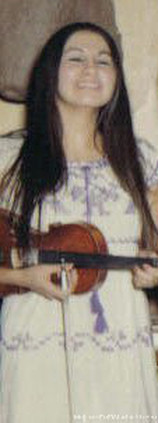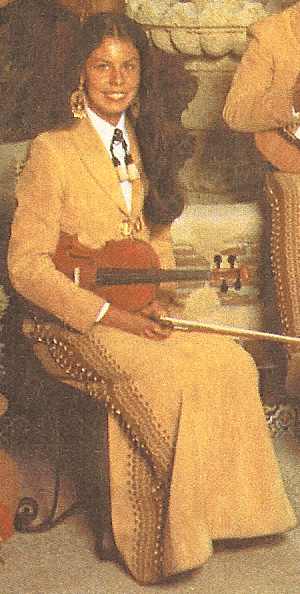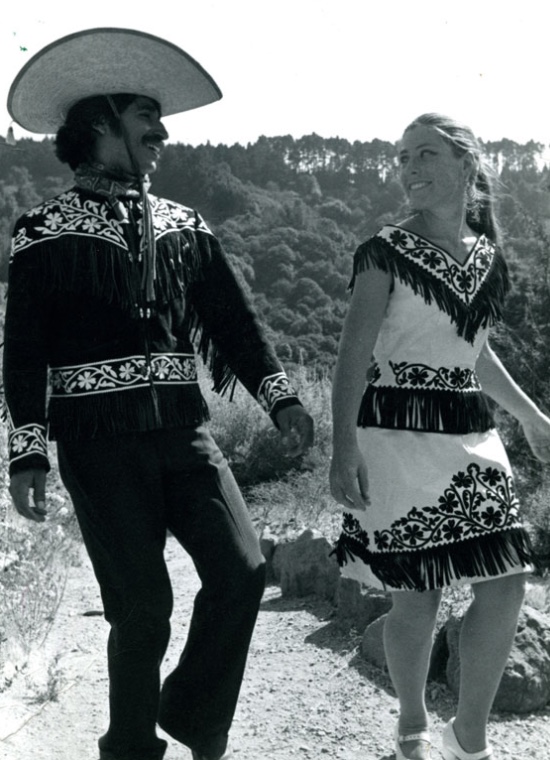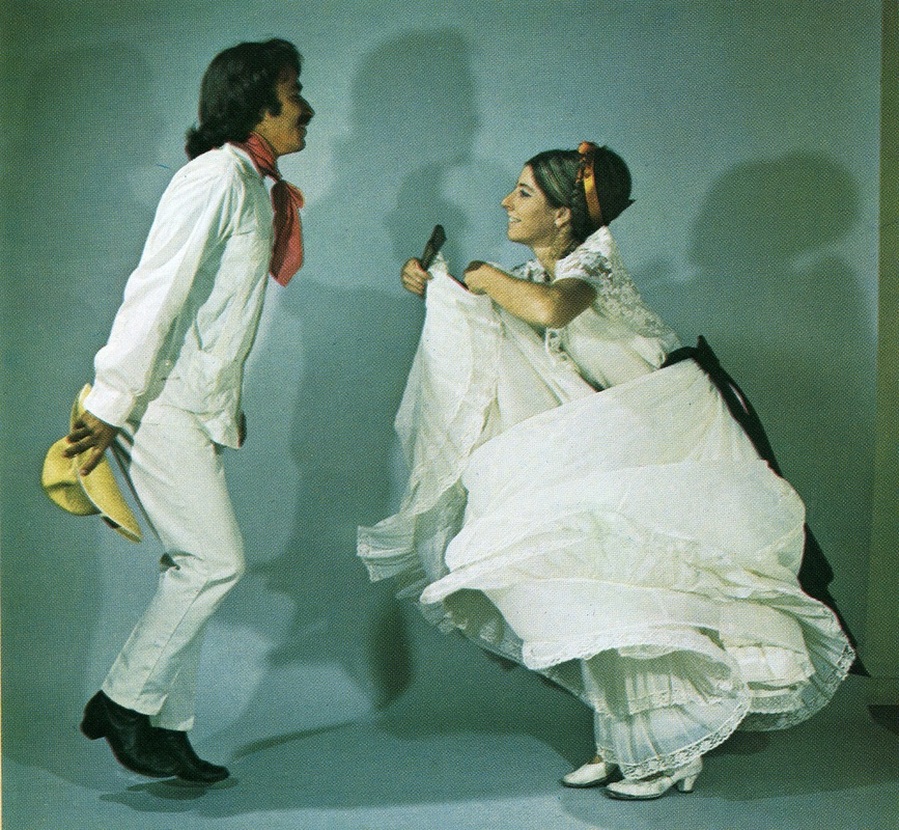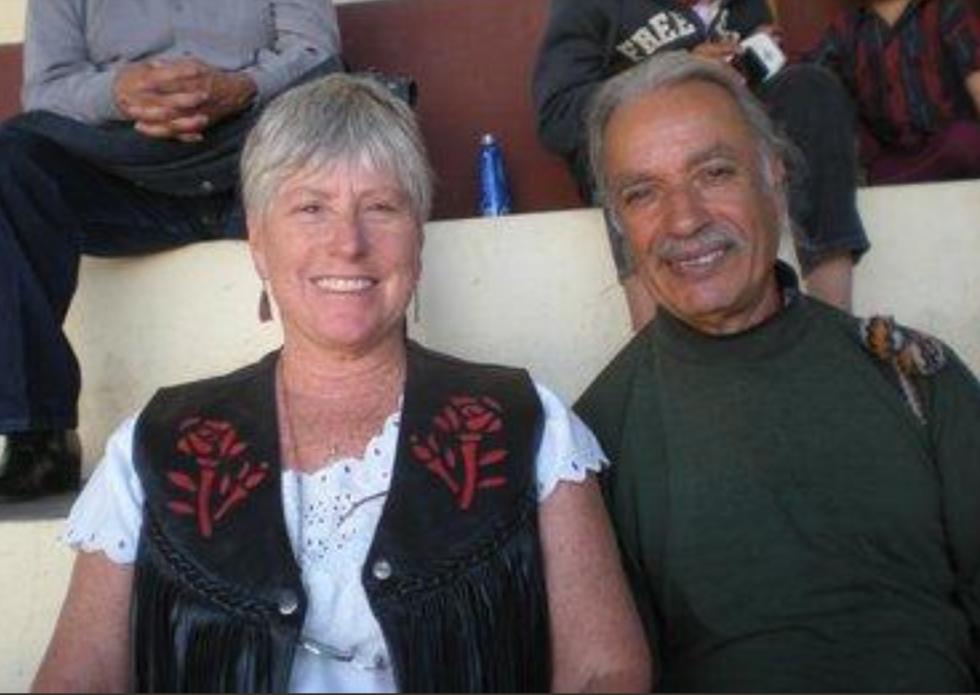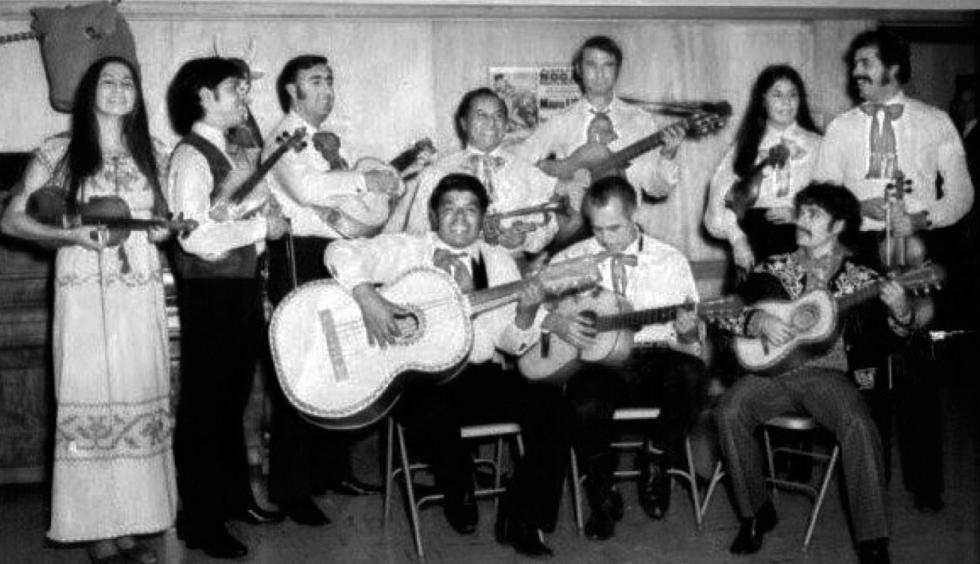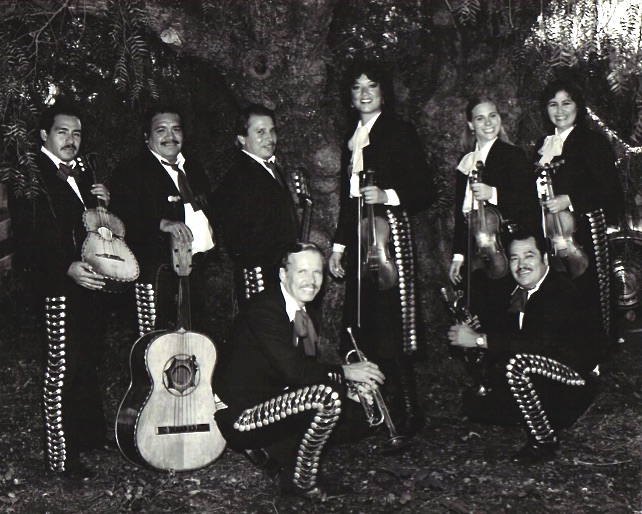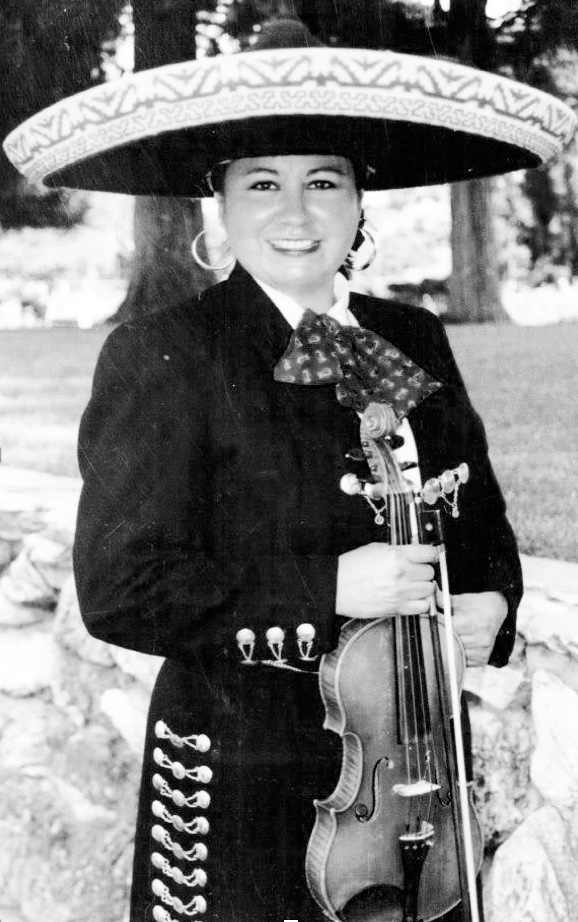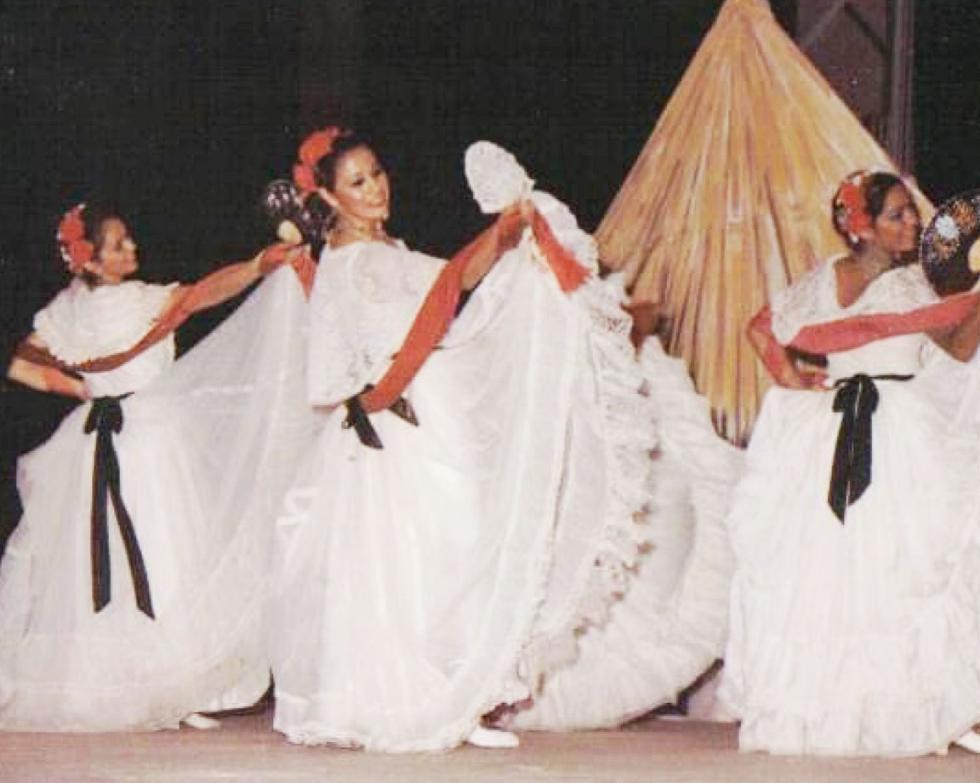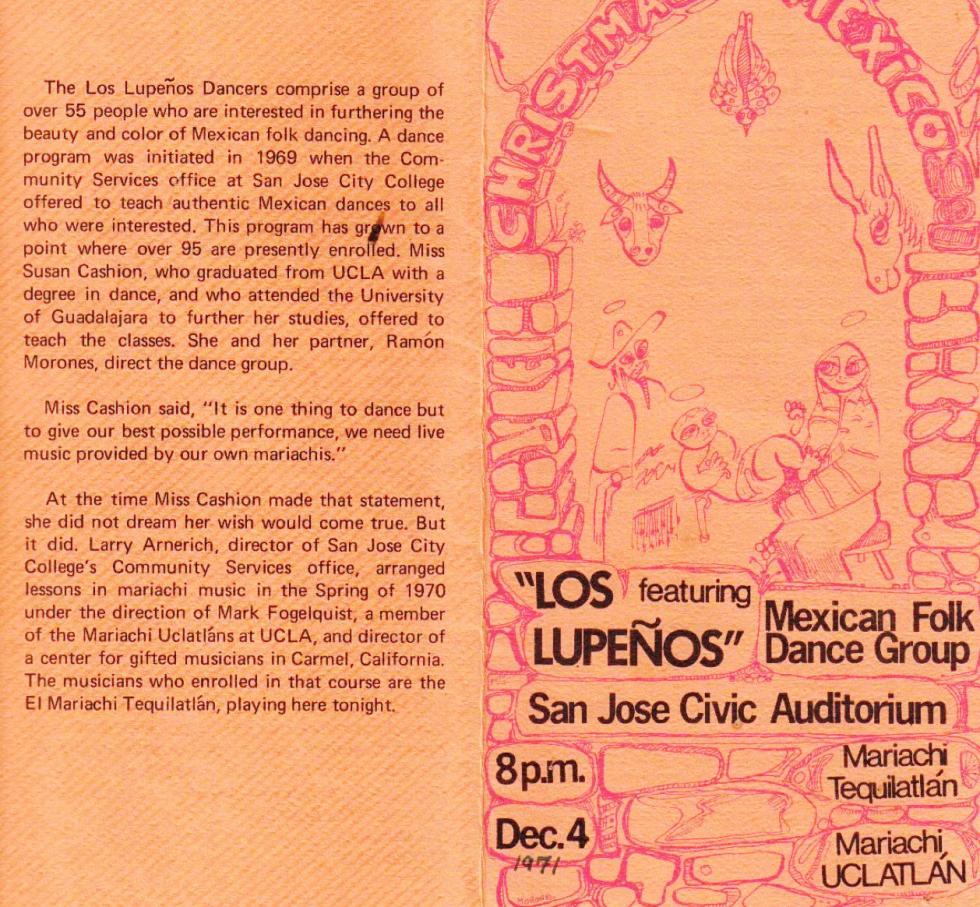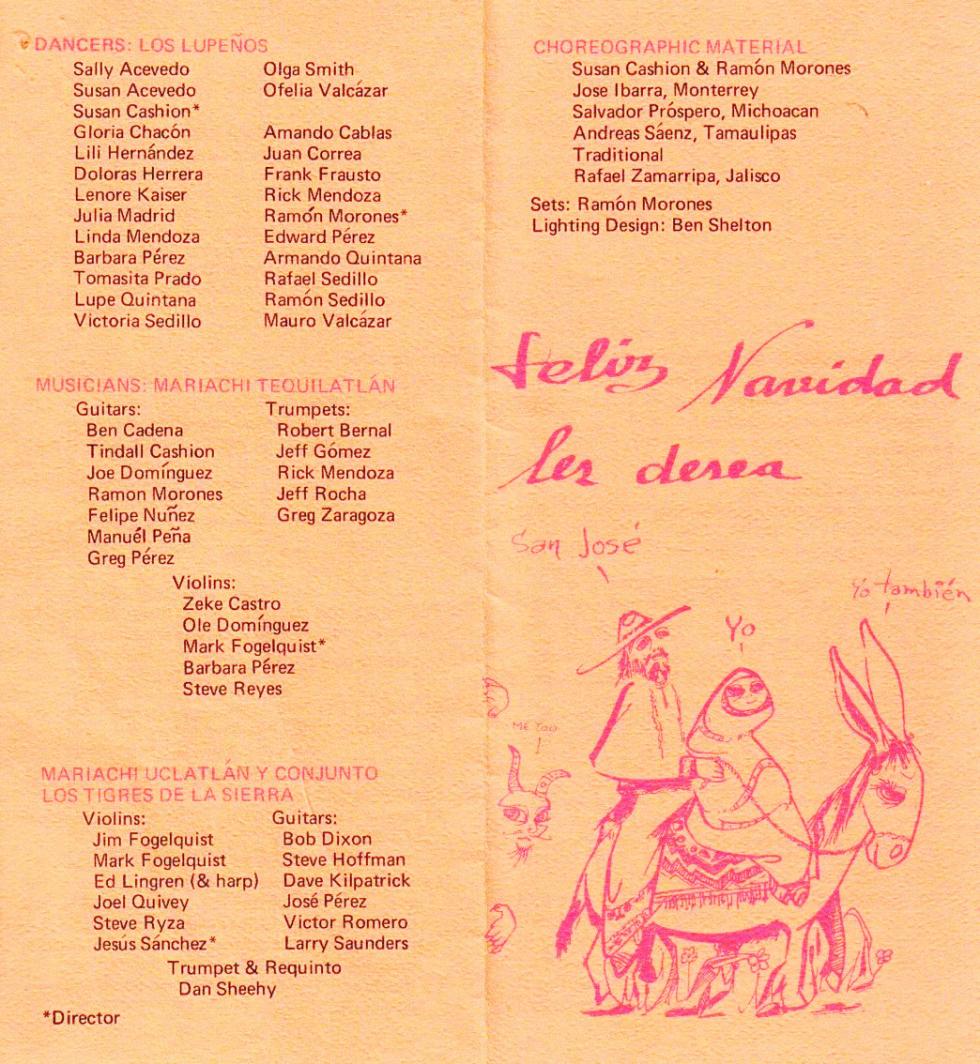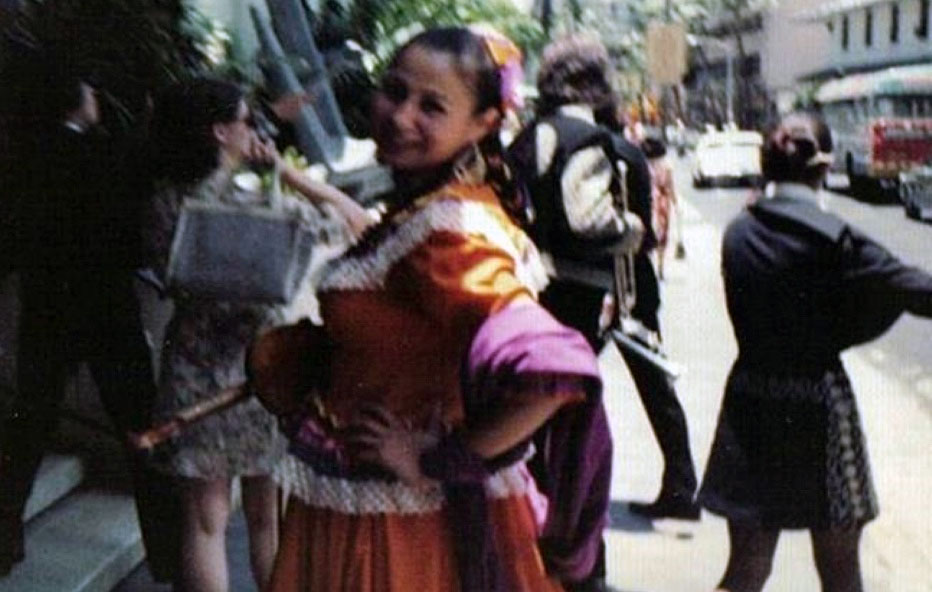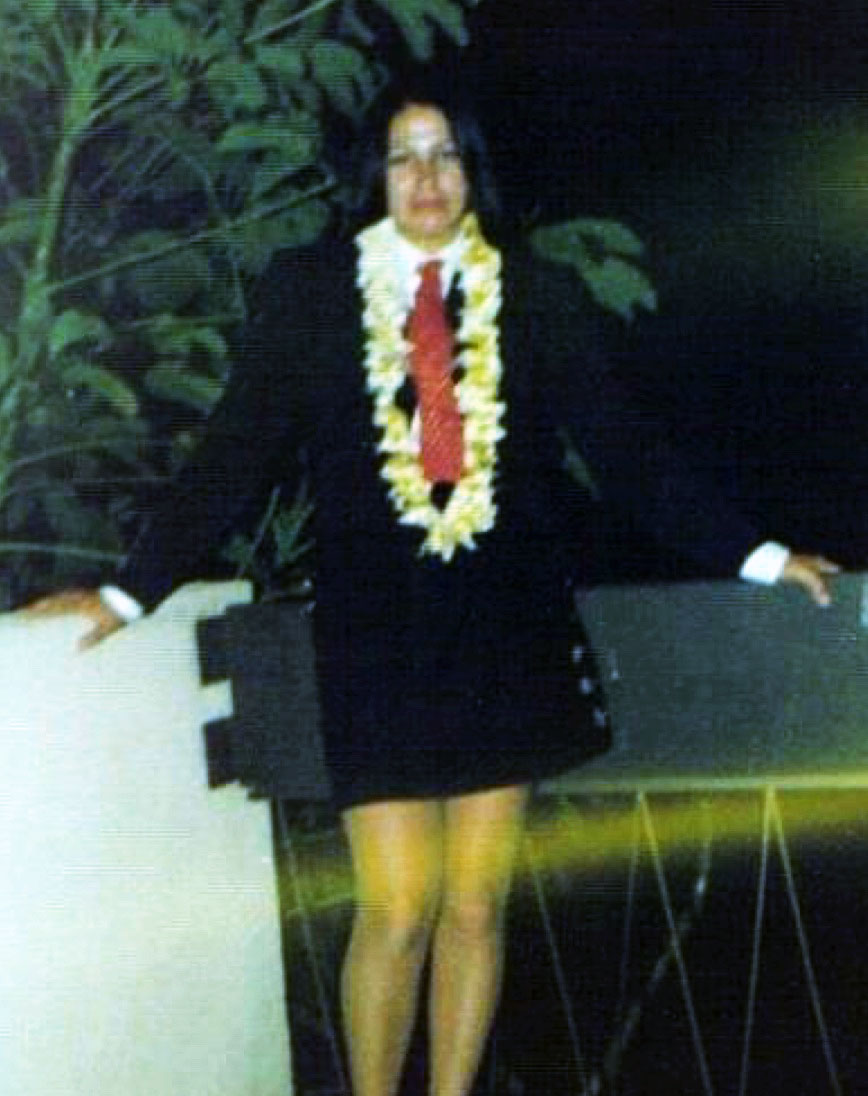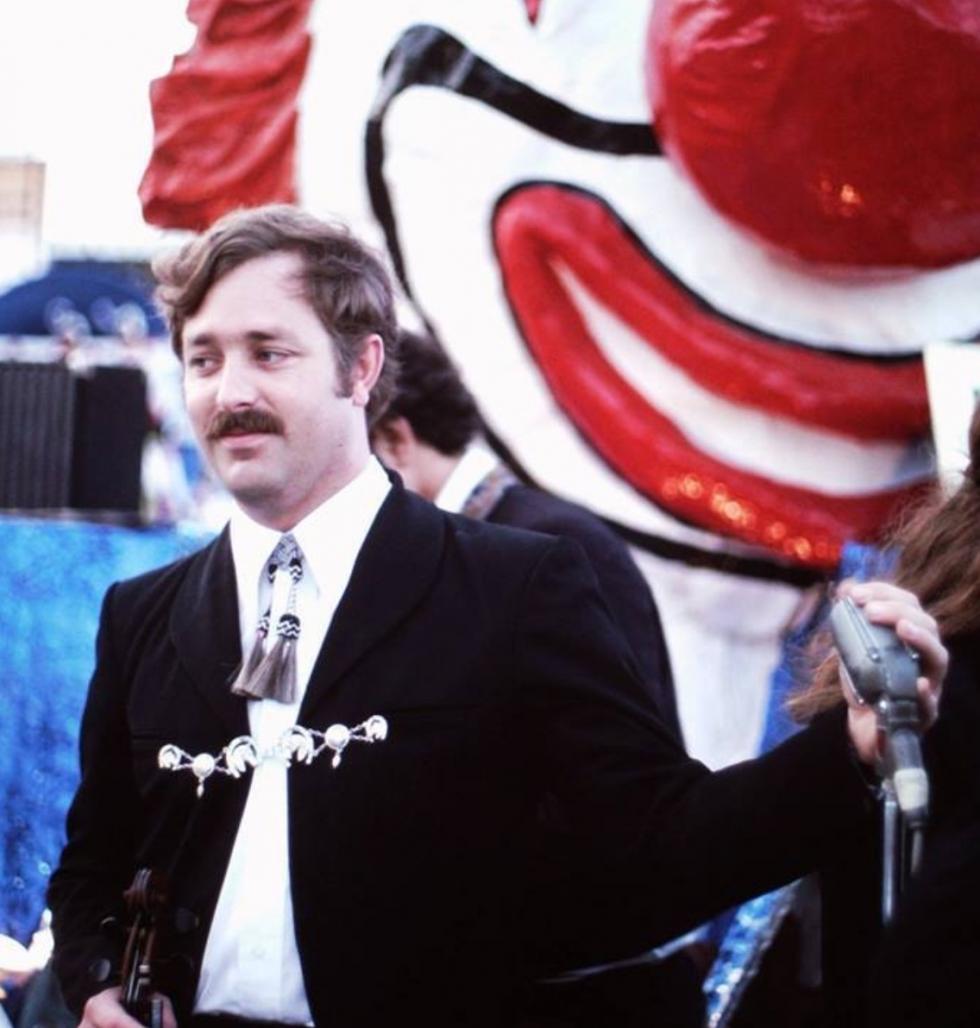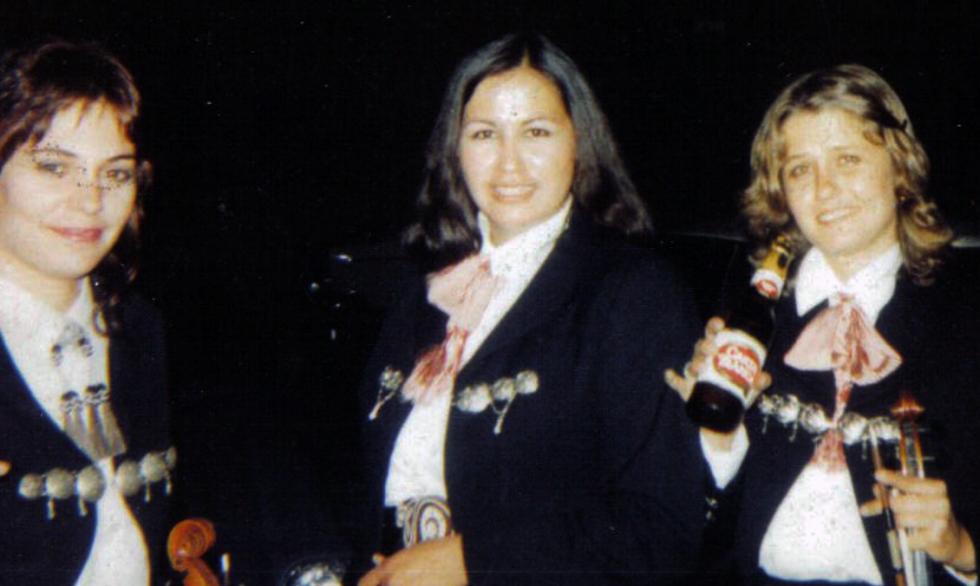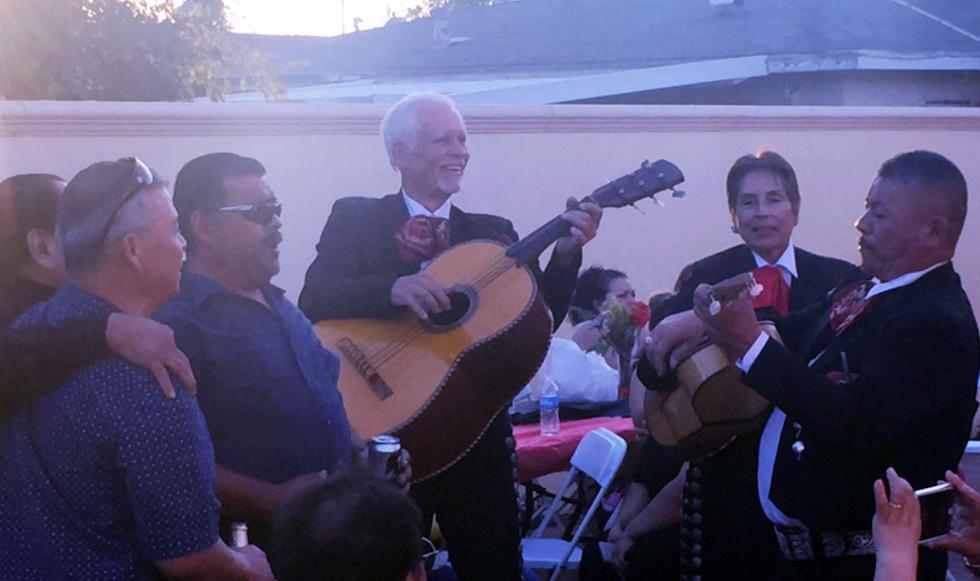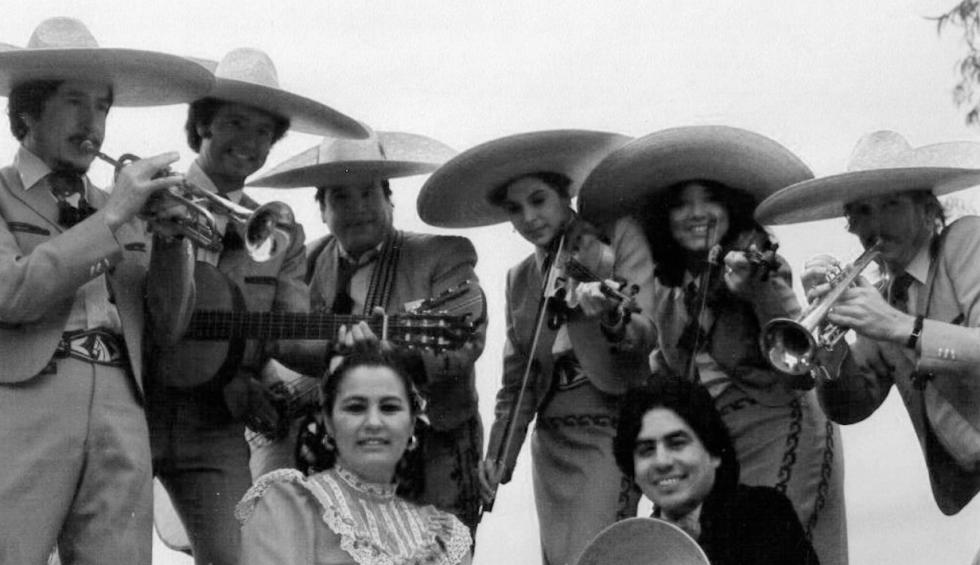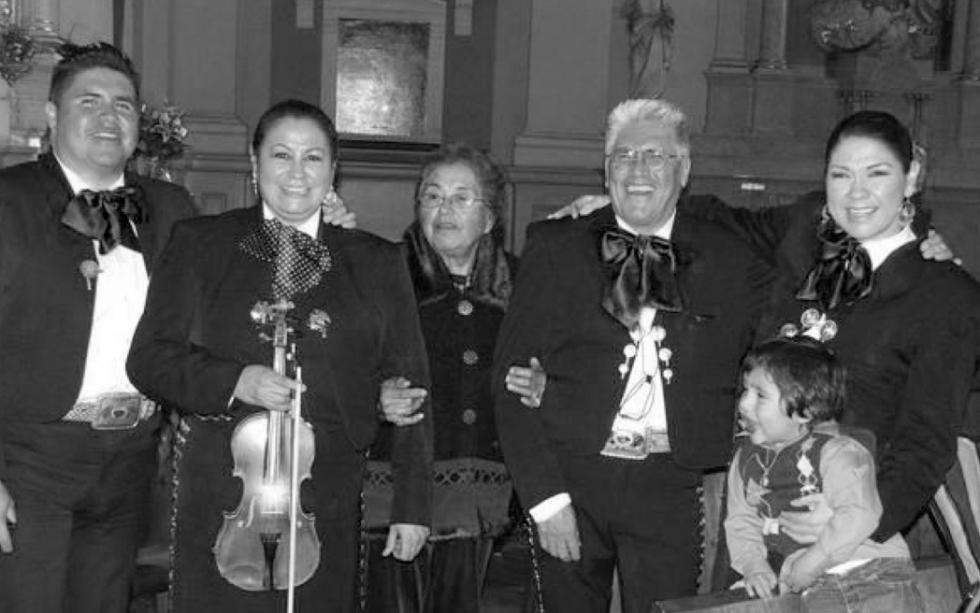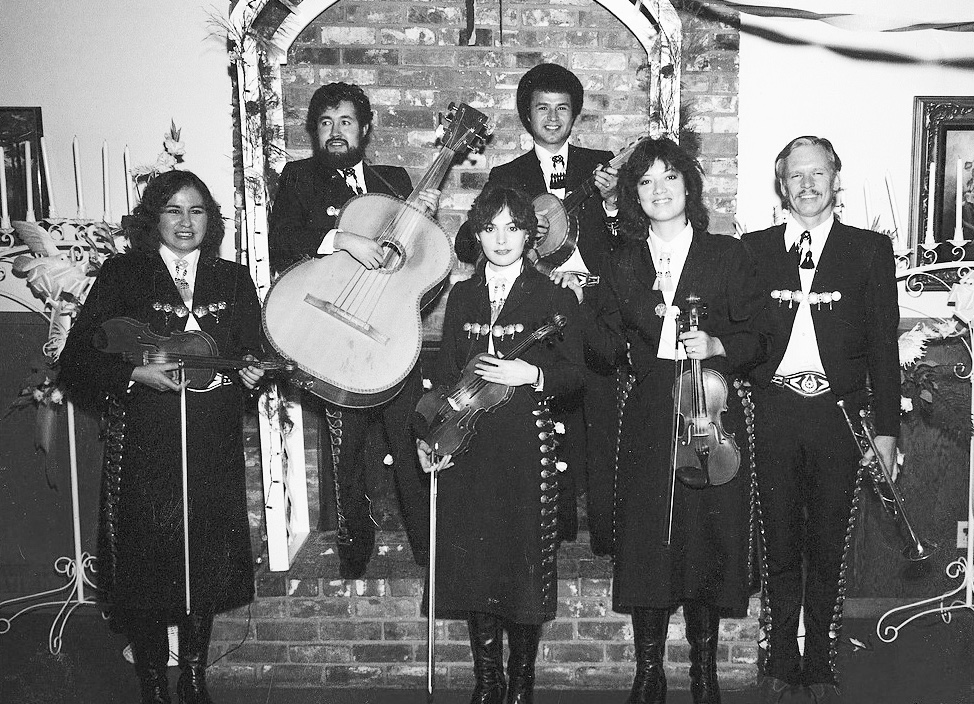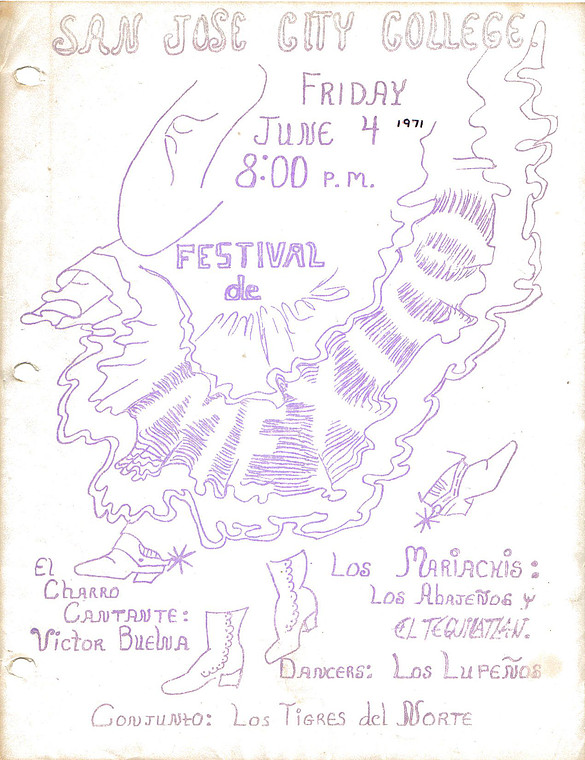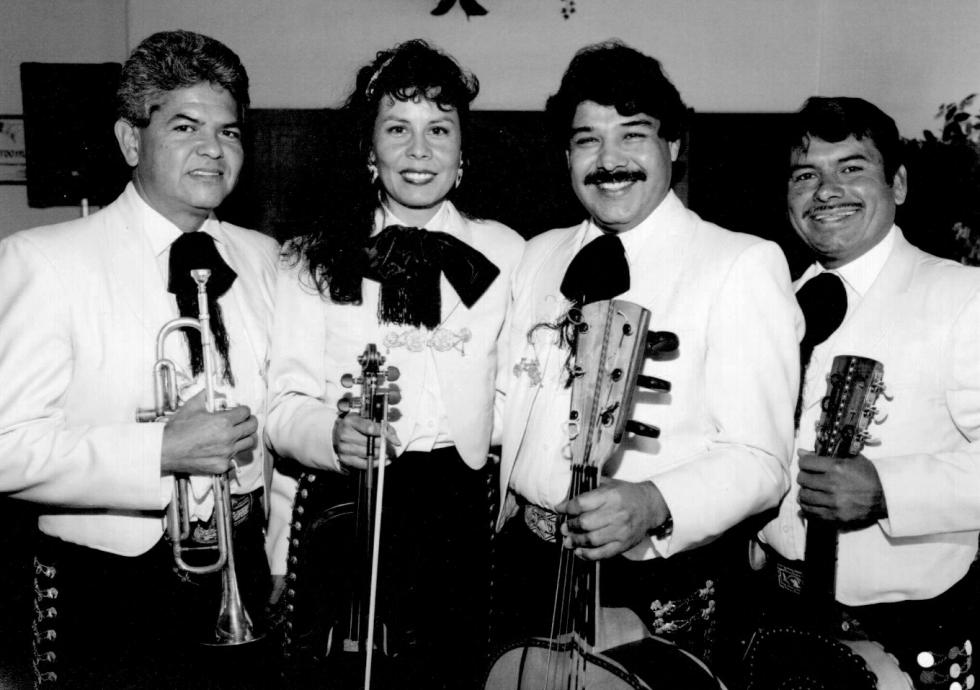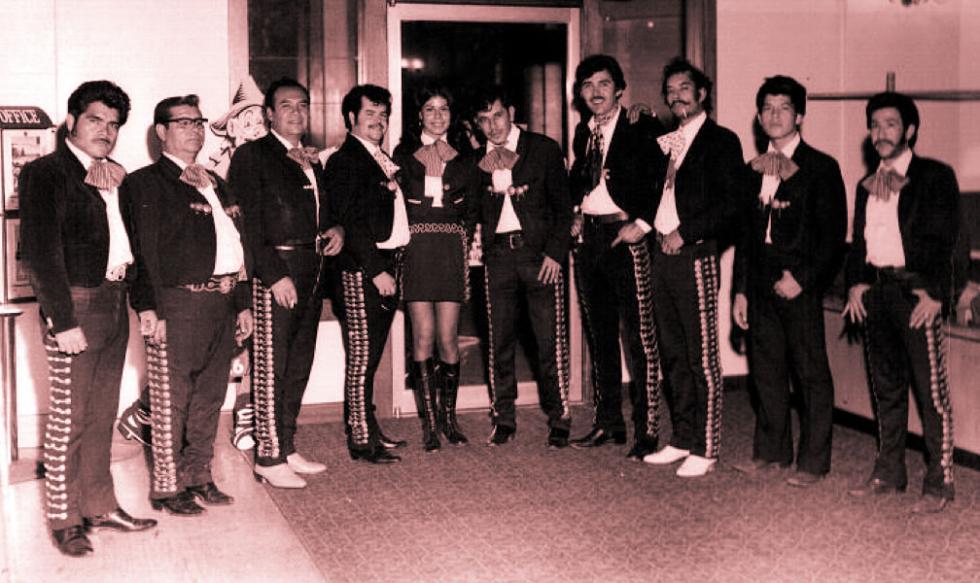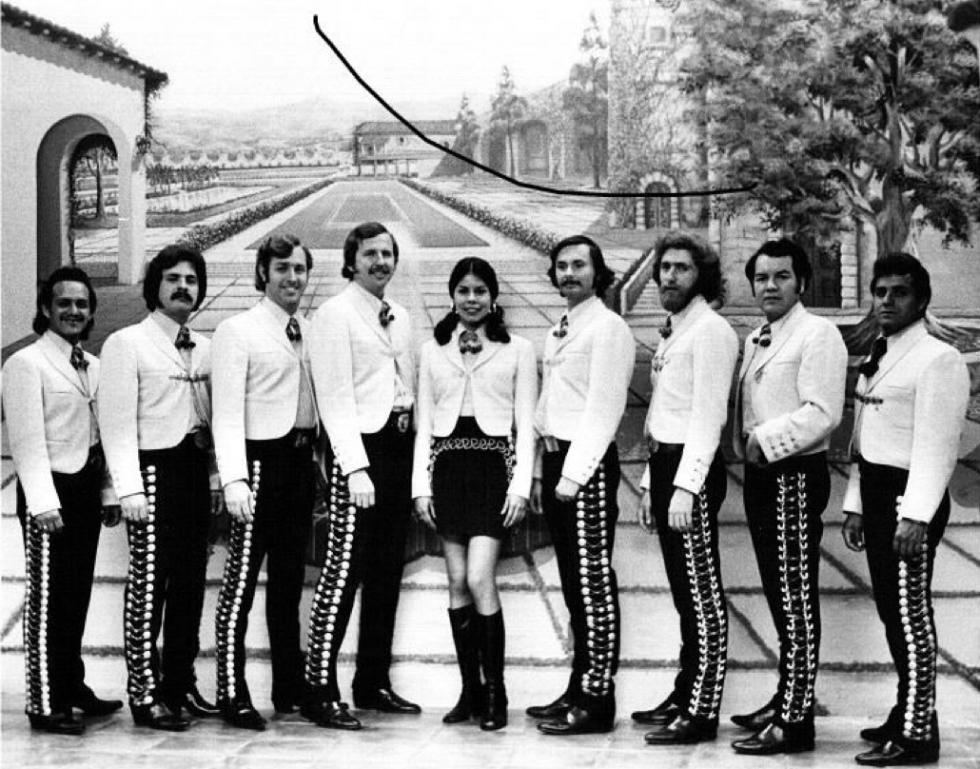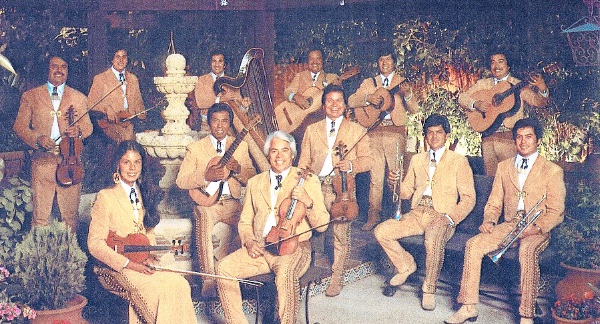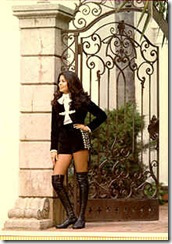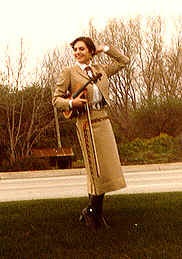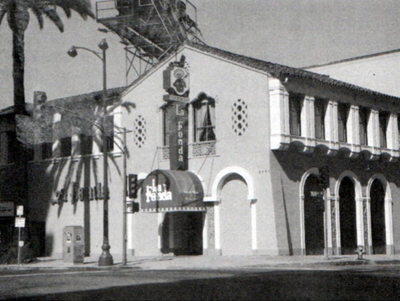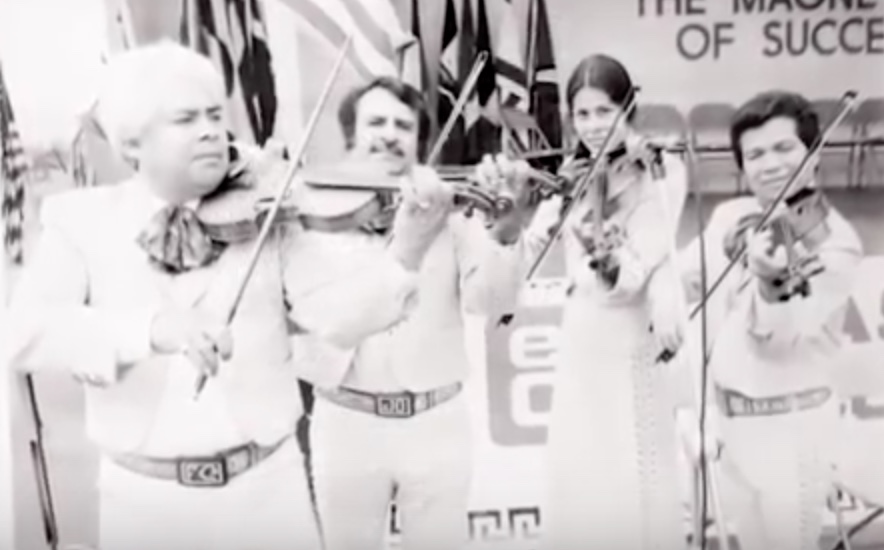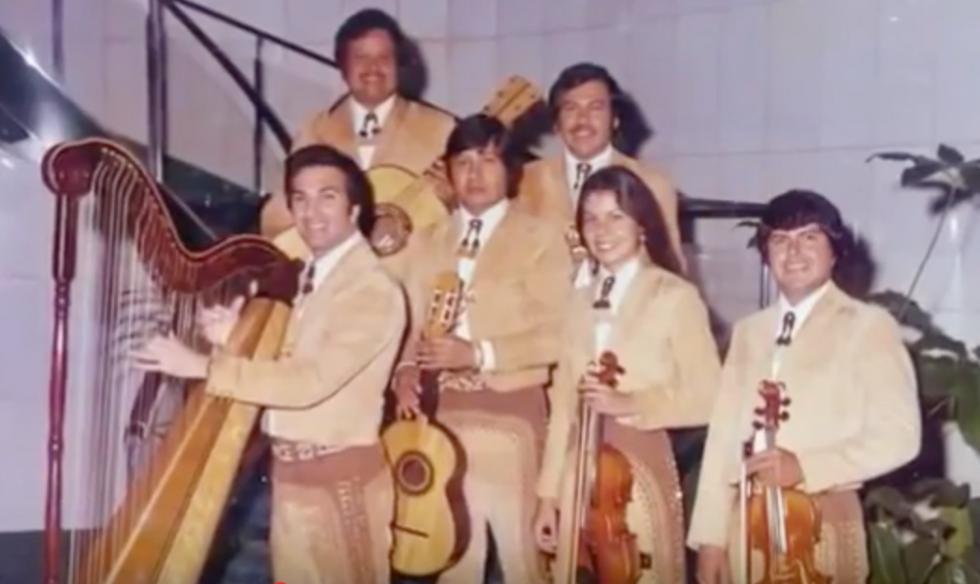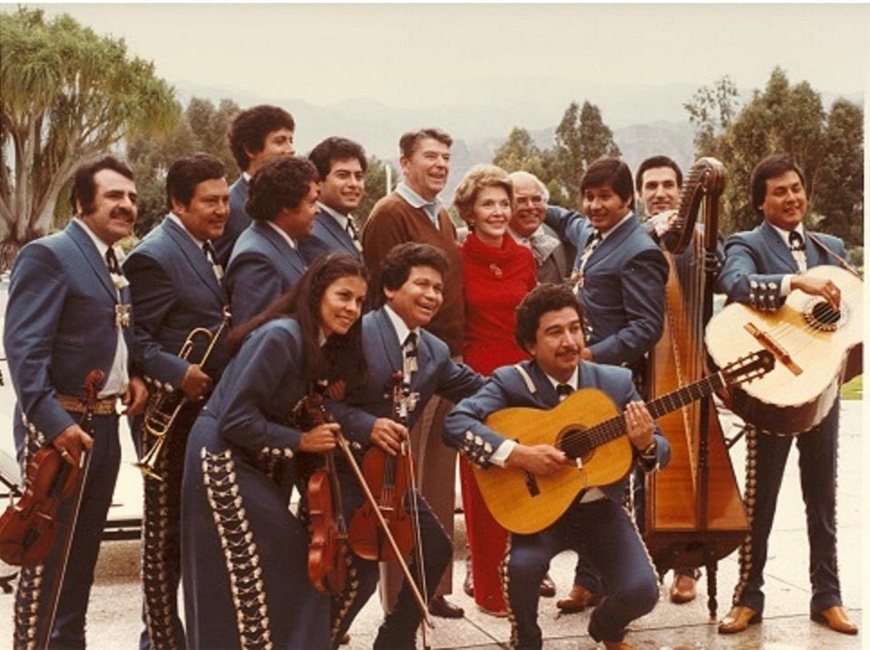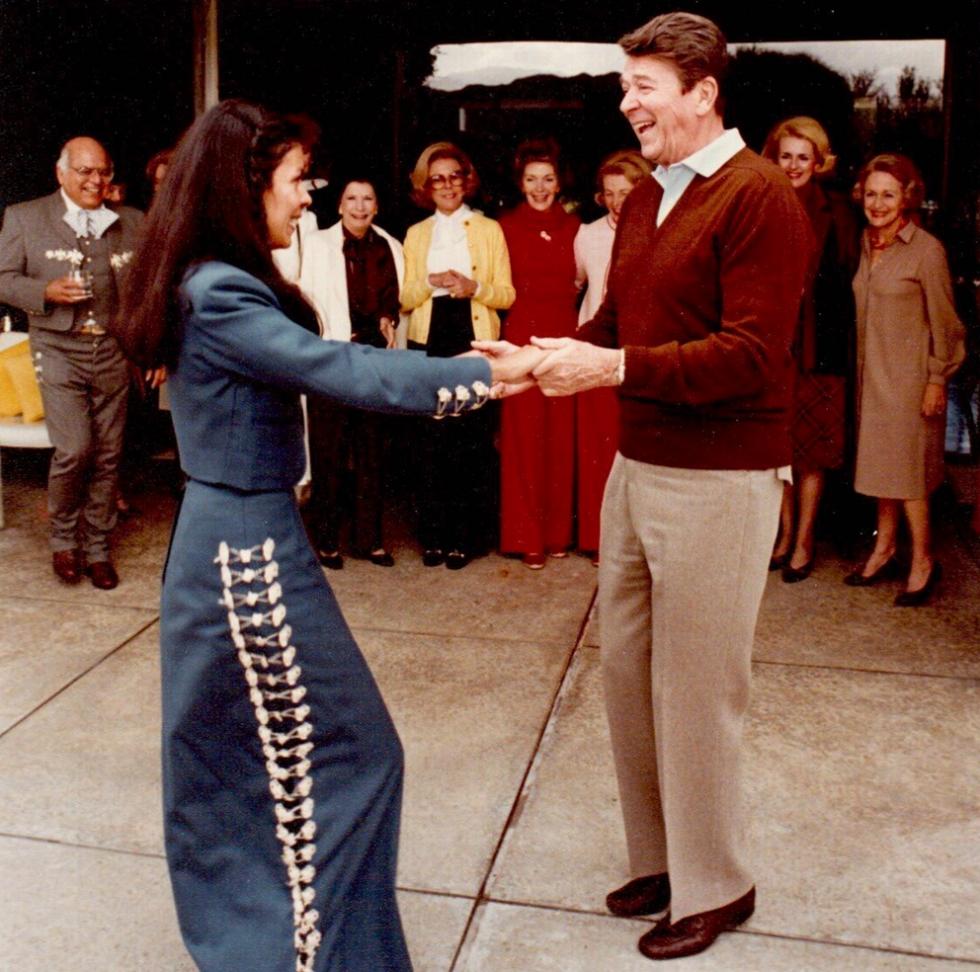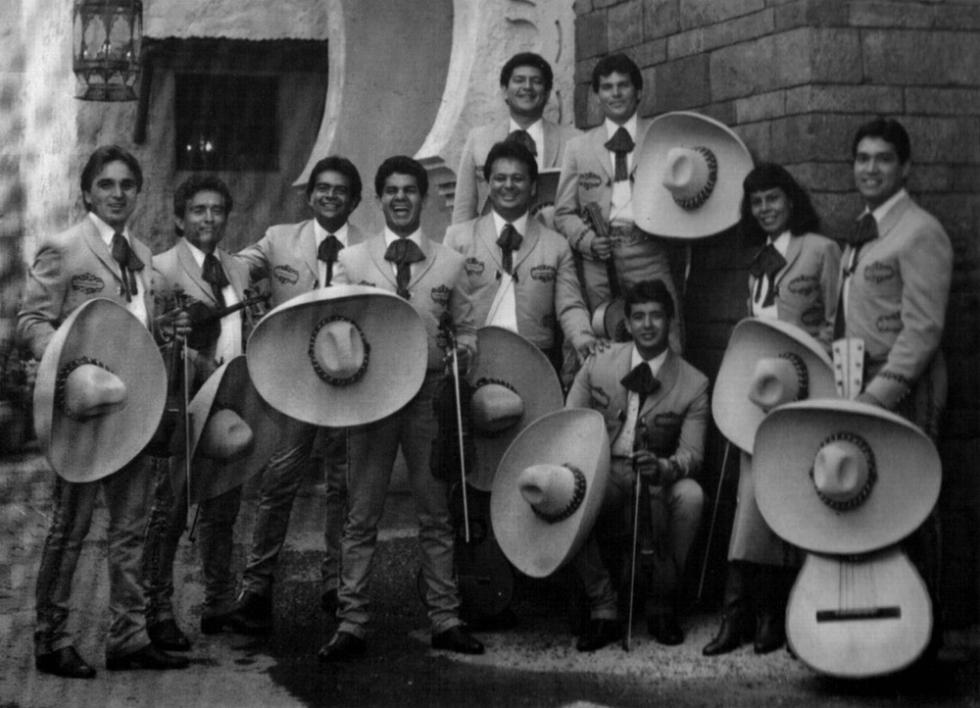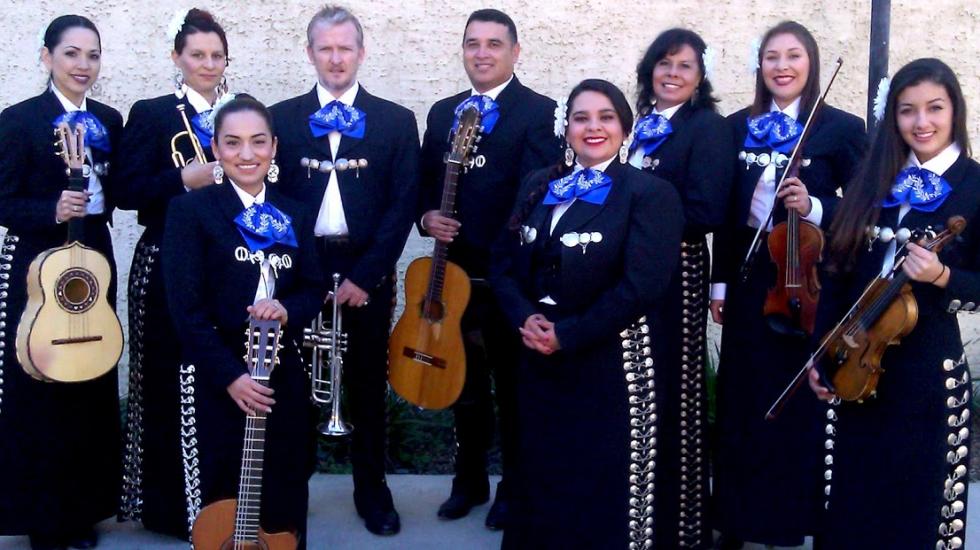KARPA 10 (2017) : TEATRALIDADES, DISIDENCIAS y LIMINALIDADES, II. ~ HOME PAGE Journal of Theatricalities and Visual Culture / Revista de Teatralidades e Cultura Visual ~ ISSN: 1937-8572 ~ Peer-reviewed Publication Indexed by the MLA International Bibliography & EBSCO ~ General Editors: Paola Marín & Gastón A. Alzate ~ GUEST EDITORS: Eduardo Reinato, Roberto Abdala Jr. e Robson Camargo ________________________________________
“Barbara Perez-Díaz y Rebeca Gonzales. Women Pioneers of Mariachi in California. The Cultural and Transnational Implications”. (PDF)
Corazón de México / California State University-Los Angeles / University of California – Riverside
Bárbara Pérez-Díaz, Mariachi Los Caltecas (1971), y Rebeca Gonzales, Mariachi Los Camperos (1976)
[ * ] Cynthia Reifler-Flores has been a professional mariachi and music educator for more than 20 years and has shared venues with the world’s greatest mariachi musicians throughout North America. Reifler Flores was an original member of Mariachi Reyna de Los Angeles, the first all female-show mariachi in the U.S., and served as acting director for almost nine years. She was also a member of the Grammy award winning Mariachi Divas. Currently Reifler Flores is the Director of the Golden Eagle Mariachi (Cal State Mariachi band) and Mariachi Los Alteños from the University of California Riverside, and performs with Corazón de México, an all female mariachi quartet.
____________________________________________________
Abstract: The present essay focuses on two mariachi women from Northern California, Barbara Pérez-Díaz and Rebeca Gonzales, who were one of the first women to participate in and continue to perform mariachi music at a professional level in the USA. This paper is part of a wider research that explores the period of women’s initial entry into the mariachi workforce through oral histories of two sets of female mariachi performers in California during the 1970s. Karpa published in 2015 (Karpa 8) an article by Cynthia Reilfer Flores on Las Generalas, Maria Elena Muñoz (founder and vihuelist) and, Adela Valdez (guitarist).
By basing the major research of this investigation on interviews with actual participants the article hopes to achieve a history that conveys not only the transnational aspect of folk music and nationalism, nor simply its transcultural implications vis-à-vis gender politics, but also hopes to portray vividly what the access to a music so highly charged with nationalism, traditionalism, and machismo has meant in the daily lives of the female participants who have slowly and steadily been changing the face of the reflection which most represents the national image of Mexico to its nation and to the world.
Keywords: Female Mariachi / Women in Mariachi / History of Mariachi in California / Las Generalas / Barbara Pérez-Díaz / Rebeca Gonzales
____________________________________________________
Introduction
Each of the women whose story follows started playing mariachi music during the 1970s and pursued mariachi music as a career. All of them play violin, and all started their mariachi careers in Northern California. Each of these women also has a special significance in the story of women in mariachi. They were each a first in some aspect and continued on to make a career out of performing mariachi music. Whereas other women/young girls were in the position to do the same, the others did not. The women each mention other young girls who started with them or went to a class with them or went to rehearsals or played for a little bit. Mostly, I included their names in the histories, because their presence was significant and indicative that women saw an opening, an entrance into the mariachi world. But only these four walked through that door and stayed.
Although each of these women was located in the San Jose area, they were all directly or indirectly brought aboard the mariachi bandwagon through the influences of University of California at Los Angeles (UCLA) graduates. It is an understandable phenomenon that cultural change would first manifest itself in a large metropolitan area, as was the case for the importation/adoption/dissemination/acceptance of the Mexican artistic culture to the world of academia in the Los Angeles area during the late 1960s and the 1970s as an auxiliary movement to the political Chicano movement. The unusual aspect of this is that this movement vis-à-vis the mariachi failed to include women until its trajectory took it to northern California. There the work of several non-Hispanic UCLA graduates influenced the participation of women in mariachi.
The Catalysts
The first cultural catalyst to be present in San José was Susie Cashion, who in 1969 as a recent graduate from UCLA with an M.A. in dance, formed, along with Ramón Morones, the Los Lupeños[1] dance troupe, a dance company that still exists to this day.([2]“The company began as a study-performance group of Mexican dance and culture”[3], and was one of the earliest ballet folklórico in the United States[4]. Los Lupeños has been dedicated to community participation and outreach since its inception. So, when Susie Cashion, decided that Los Lupeños could also have a student group, it was natural for her to open her doors to the community to include whoever was interested. The goal was to have a company mariachi who would learn the songs to which the troupe danced. Susie did not discriminate based on race or gender. She encouraged anyone who was interested to participate. She encouraged the breaking of tradition, perhaps intentionally but more likely as a means to achieve her goal. Very likely the fact that she was not from this cultural tradition was a factor in her willingness to overlook customary mores based on gender and race. Susie’s vision provided the impetus for Barbara Perez-Díaz, the first of the pioneer women, to participate in the realm of mariachi as a member of the Los Lupeños’ Mariachi Tequilatlán. When Susie’s number one choice for mariachi coach became unavailable, she recruited Mark Fogelquist of Mariachi Uclatlán[5] as their musical director.
1 y 2- Susan V. Cashion, PhD (1943-2013) and Ramón Morones Ortiz (1939-2011) c. 1970 (Taken from http://cashionculturallegacy.org/founder/, for educational purposes). 3- Susan Cashion and Ramon Morones c. 2011. (Taken from http://www.mercurynews.com/2011/08/29/memorial-planned-for-bay-area-folklorico-dance-maestro-ramon-morones-killed-in-mexico/, for educational purposes).
Mark Fogelquist was born in 1947. He grew up in Pacific Palisades, California and received a B.A. in Music from UCLA, although his family lived for a brief period in Mexico. Mark pursued an MA in Ethnomusicology and received it from UCLA in 1975. His thesis, “Rhythm and form in the Contemporary Son Jalisciense” is considered by scholars of mariachi to be the seminal English language work on the subject of mariachi. When Mark was invited by Susie Cashion to teach the Los Lupeños mariachi class he had not yet completed his M.A., nor had he taken over the directorship of Mariachi Uclatlán. In northern California, in addition to teaching for Los Lupeños, he became involved in teaching classes for San Jose City College and another educational institution in the Monterey Bay area. Mark’s enthusiasm and love for the music was as infectious in the 1970s as it is today. He was successful at recruiting Rebecca Gonzales and providing her with her initial training in the mariachi genre. As director of Mariachi Uclatlán, he invited Rebecca Gonzales to join, making her the first female to play in a show mariachi.
He also recruited Laura Sobrino, then Garcia, for the group. In addition to exposing Rebecca to this music, he also introduced the genre to others, including two non-Hispanic musicians, Jon Clark and John Rialson, who in turn recruited Kate Woods. Jonathan Clark’s instrument is the guitarrón. Today he is best known for being the foremost mariachi historian in the United States and is considered a respected and knowledgeable scholar on this subject on both sides of the border. He is also known for having gone to Mexico City and having worked there for a period of about ten years as an illegal immigrant. He has taught classes on mariachi history at all the Mariachi workshops of import and was the founder of the Mariachi Workshop Classes at San Jose State University in the 1990s. John Rialson is from Los Gatos California, a neighboring town of San José. He plays trumpet and is known as “El Barbón”[6], the bearded one. He has worked in numerous local mariachis, has taught trumpet at the beginning level at various Mariachi festival workshops and has been the director for the Mexican Heritage Corporation of San José’s Mariachi Youth Program. John Rialson started playing mariachi through the Los Lupeños mariachi class, which he heard of from a girlfriend who was a dancer. Jon Clark and John Rialson are frequently referred to as “The Johns”. They formed the Mariachi Aztlán in the early 1970s, a group which is still remembered locally for its naiveté and enthusiasm at its inception, because they did not feel they were capable of integrating into any existing local mariachi. Both men have made a career of the music and have performed continually since the 1970s.
Geographically on the other side of the hill from San José lies the small town of Santa Cruz, home to the University of California at Santa Cruz. David Kilpatrick graduated from UCLA with a PhD in Ethnomusicology, was a Fulbright scholar and was a professor at the University teaching ethnomusicology with emphasis in Greek and Mexican music in the 1970s and 80s. The university group that he formed was Mariachi Santa Cruz. Barbara Perez–Díaz played in this group with her future husband, Juan Díaz, “El Pato”, who later became the director of the best mariachi in the San José area, Mariachi Azteca. Mariachi Santa Cruz is the group in which Laura Sobrino started performing while a student of David’s at UCSC. The band eventually evolved to become a professional working mariachi under the name of Mariachi Los Caltecas. Laura Sobrino, Kate Woods, Barbara Perez and myself all played in this band at various times, including a number of years when the four of us were all members simultaneously and comprised the entire violin section of the mariachi. David also taught the Los Lupeños mariachi class after Mark Fogelquist.
Mariachi Tequilatlán. Church function in Los Gatos, California, circa 1973. L-R. Back: Barbara Pérez, Esteban Zapiain, Manuel Peña, John Valcazar, Kim Dunn, Rebecca Gonzales, and Zeke Castro. Front: Felipe Nuñez, Gregorio Pérez, Ramón Morones. (Private collection of Barbara Pérez-Díaz, courtesy of Cinthia Reifler Flores).
The Pioneer Women
Barbara Perez-Díaz works at the Santa Clara hospital and has worked there for over twenty years. She participates in the annual NAMI (National Association of Mental Illness) Walks,[7]Danzantes Unidos[8], and the San Jose Mariachi Festival. She was one of the founders of the Mexican Heritage Corporation sponsored Mariachi Youth program which has grown from its inception to include at one point over fifty schools. Barbara’s children are the first to have been born to a professional mariachi couple. Barbara was one of the first women to participate in the mariachi at any level and the only one from the very first group of female participants to continue playing and become part of a professional group, effectively making her the first female mariachi in Northern California, most probably in all of California and perhaps even in the entire United States.[9]
Rebecca Gonzales has been mentioned in numerous accounts of women in mariachi and has served as adjudicator for many mariachi competitions. She has the distinction of having been the first woman of many to have been a member of Mariachi Uclatlán. She was the first of three women ever to play with Mariachi Los Camperos[10], the first and longest existing show mariachi in the United States, and she was the first and only female member of Mariachi Cobre, the first professional show mariachi to be born from a student group[11]. Rebecca teaches Suzuki violin and has been a band leader for a gig band for many years. She recently formed Mariachi Tesoro, and has released a CD with that group. She never had children. Currently, Rebecca lives with her domestic partner[12] of eighteen years in Palos Verdes outside of Los Angeles, California.
During the 1970s there were many non-Hispanics who started studying and performing with mariachi groups. Kate Woods was the first non-Hispanic woman to immerse herself in the mariachi lifestyle and continue to a professional level. In addition, Kate’s mariachi career was centered around the San Jose area, where she dedicated herself to the talon style and aesthetics.[13] She is the only one from this era to have done so. Kate left the mariachi after an accident in which her left arm was almost severed and she nearly lost her life. In 2009, she was in a near fatal car accident which put her in a coma for weeks and left her with a head brace screwed to her skull for several months to accommodate her broken neck and prevent paralysis. Kate never married and like Rebecca, never had children. Kate has had a successful writing career, having been a reporter for a scientific publication, The Space Daily[14], an award-winning columnist for the San Benito County Herald and the author of a published novel, “Quicksilver Chronicles”,[15] a book based on her stranger-than-fiction true-life events. She currently lives in New Idria with her older brother where they maintain an off-road vehicle park. She is a successful local artist, sought after for her amazingly detailed and whimsical portraits of pets.
Mariachi Los Caltecas, Circa 1985. Back: L-R Guadalupe Preciado, Trinidad Preciado, Rogelio Peña, Laura Sobrino, Cynthia Reifler (Flores) Barabara Pérez-Díaz. Front: David Kilpatrick, Francisco Moreno. (Courtesy of Cynthia Reifler Flores)
Of the four women, the one with the highest profile is Laura Sobrino (at that time Laura Garcia), who was, after Rebecca, the second woman in the professional Mariachi Uclatlán. She was also the first to perform with the renowned and highly acclaimed Los Galleros de Pedro Rey[16] and subsequently the currently prestigious and controversial Mariachi Sol de Mexico[17]. In addition, she was the first musical director and a founding member of Mariachi Reyna de Los Angeles,[18] the first all-female show mariachi in the United States. Laura is currently the musical director of Mariachi Mujer Dos Mil (MM2K), an all-female mariachi directed and owned by women. She teaches mariachi at the University of California at Riverside and is a frequent teacher/lecturer at Mariachi Festivals throughout the United States. Laura is one of the leading researchers on the history of women in mariachi and maintains a website on that subject, where she also sells her musical transcriptions of mariachi songs. She is married and has two adult children.
Barbara Perez-Díaz
Barbara Pérez- Díaz (Personal collection of Barbara Pérez-Díaz, courtesy of Cynthia Reifler Flores).
Family Background
Barbara Kathryn Perez was born on September 17, 1954, in San Jose, California, the third of seven children and the first of three girls. Her parents were both born in the United States. Her father, Gregorio Perez, was born in Tulare, California of parents also born in the United States. Currently living in San Diego, her father had previously retired to Tijuana to a property which he sold as he went up in years, preferring to be on this side of the border and closer to Kaiser Hospital. Her mother, Luisa Delgadillo, was born in Seligman, Arizona of emigrated parents and grew up in Seligman and in San Jose, California. She currently lives just outside of San Jose in Campbell, California, in the house that Barbara grew up in, just down the street from where Barbara now lives with her family. Luisa is a high school graduate and also has an AA in Childhood Education.
“And my Dad, my Dad, we think he went up to the third grade.” Both parents are bilingual. Interestingly, Barbara categorizes her mother, a first generation American, as having a primary language of English whereas she considered her father a second-generation citizen to have Spanish as his primary language.
My dad worked as a janitor for the Campbell Unified High School District and then he was hired on in the same District as a teacher’s assistant. He did all the printing for the Campbell Union High School District. He ran the printing press.
Barbara’s mother did not “work outside the home” but was involved in the community. Her volunteerism was an outgrowth of her connection to her Mexican heritage. In addition, her mother’s community efforts demonstrated her own personal strength.
On her own, she would help a lot of people, [some] who couldn’t even dial a telephone [or] know numbers, or get on a bus or write or how to read, she would help people in that sense, whether they needed forms filled out [or] if they needed an interpreter ...That sort of thing. And to the day. [Laughs] Some still haven’t learned how to read.
My Mom was very supportive of the [United Farm Workers] movement. When the strike broke out in Delano, she took us. We stood with the people. We never marched. I remember seeing Teatro Campesino[19]. That was the first time I saw Teatro Campesino. And I was young, sheesh. I remember them being on the back of a flatbed truck and I liked that. I liked that they had guitars and I was drawn to it, the masks and gestures. My mom, she would let the campesinos[20] here in this area stay in our yard or she’d feed them. But other than that, no, she wasn’t actively involved with the movement, with Cesar Chavez. She knew who they were. A lot of that activity was taking place here in San Jose, she worked with a lot of community organizers, but not in the farm workers’ movement; not in the thick of it but kind of on the outskirts.
The children helped out to bring income to the family household.
Yeah, we picked prunes and that’s how we got our clothes for school. [We’d] cut apricots, [pick] walnuts. Our hands would get all black. Just for the summer. My mom knew all the ranches around here, the work area. It was more orchards, All through grade school we [would work]. Every summer through high school we’d go.
Summers were also a time of travel for the family. They would pile in the car and drive to Mexico for a two-month trip. Sometimes they would stay with relatives.
Sometimes. Then, sometimes we’d live in hotels, motels with kitchenettes. [Not to live, they were] just trips with my Dad. Vacations, summers spent in summer school. In Mexico. Ooooo!! Guadalajara, Jalisco, Michoacán, Tamaulipas, I think Jalisco is pretty much the farthest we traveled when I was with my parents. And also, Sinaloa. Ah, Mexico City. We went to Mexico City. My parents did [explore a lot.]. They took us everywhere. All in the car!!!
The trips to Mexico served as reinforcement to the family’s ownership of their cultural ethos. Her parents purposely and routinely instilled a feeling of pride in and connectedness to the Mexican culture from an early age.
It was part of my family. My family instilled the values that I carry like every other person, I think. So, they would sit us in front of the TV. There was this program called Un Canto De Mexico.[21] There was a song that started at the beginning, Edward and I would have to sit in front of the TV, and our mom would tell us, “You sit there and watch it! It’s good for you”. [Laughter] Ok! When my mom spoke, we didn’t move, you know? So, the song started [singing], “Los Aztecas te formaron, luego fuiste colonial, España te conquistaron, pero nunca”[22] You know the song. [And then it went into] La Negra, I get chills right now, I have goose bumps talking about watching that show. It’s the food, it would show the music it would show the landscape, it would show children, rich, [poor], young, blancos. Morenos[23], the whole panorama of what Mexico was. It was the first program that I can remember where I still, after a while, later on, I remember the music. I remember the show. Right now, I’m a grown woman, I’m pushing sixty and the memories still give me goose bumps! The pride, it’s a pride that I can feel and it makes me … it pulls. It pulls all the good feelings, it pulls me out of any sadness I might have. [It] makes me proud. It makes me feel proud. “Un Canto de Mexico”. And it was on PBS!!! [Laughter]
Barbara’s parents headed a family that valued Mexican regional music in their lives.
They enjoyed the music, especially mariachi. They used to hire mariachis for our family parties and gatherings on occasion. My Dad plays guitar and standup bass. Just in the home and at family parties. We all took music lessons through the school system. In the fourth grade, we would start. And I played the violin. And then my brother Edward played trumpet and my brother Richard played trumpet and piano. And Connie and Mark, let’s see, Connie played piano and Mark played trumpet and piano.
We’d had mariachi and I loved mariachi. When Connie was being baptized, she’s twelve years younger than I, for her baptism I was the one who told my parents, or asked them, “Can we get a mariachi for the party?” There’s video floating around, not video, Super 8, of that party. I think one of my aunts has it. Juan Fernandez[24] was playing in the mariachi; he came to my house for Connie’s Baptismal party.
Los Lupeños de San José
Barbara’s mother was the inspiration for Barbara joining the baile folklórico Los Lupeños de San José. Given their commitment to her cultural education it was natural for Barbara’s parents to insist that she participate when classes in this Mexican art form were offered in San Jose.
Los Lupeños de San Jose, 1971. This was the performance when Mariachi Uclatlán came up to accompany them. L-R: Gloria Chacón , Barbara Pérez-Díaz, Linda Mendoza. (Private collection of Barbara Pérez-Díaz, courtesy of Cynthia Reifler Flores)
My Mom heard a request via a radio station, I can’t remember which radio station. It was, a request for students to take Mexican folk dance classes.
In San Jose. This was around March of 1969 and I think that was the only
way she heard about it was via the radio. And she took me. Against my will. My Dad promised to buy me a bike and my Mom just took me. I DID NOT WANT TO GO. I was fourteen-ish.
I did not want to stay, I should say, because I did not like my teacher, Ramon Morones. I thought he was the ugliest person. And my Mom can still quote me that I didn’t want to go, or stay because of him. I liked dancing and I had taken dancing in Guadalajara a couple of summers prior to going to Lupeños.
You know I didn’t resist too much afterwards. I would complain about Ramon but, no, I wanted to go. Cause it was just like what I saw in Guadalajara. In the Teatro Degollado, the performances there with the baile folklórico. I was attracted to it. I’d seen it and, [I thought] “Wow!
We have it here. I’ve got to stick with it.”
Barbara recognized the value of this extraordinary opportunity. She stayed with the group because she really loved the culture.
It was a passion. It became a passion. It was art. And like I said I am a private and a basically shy person so, that was like another world, being on a stage and giving it all you got, and knowing that you’re doing it well, that you know. And [it was] a first in San Jose, where it was just NEW to everybody who saw it, and…the reaction! That was really motivating.
It was through her involvement with Los Lupeños and Susie Cashion that Barbara became involved in playing mariachi music. The group performed often with live music performed by the local mariachis. “The most prominent I think at that time was Mariachi Abajeños[25] de Isidro Rivera. And Susie used them quite a bit.” She decided to use a different group for their Christmas Concert in 1970.
1- Program for Los Lupeños Christmas Concert, December 4, 1971. The back of the program gives a brief history of the dance troupe and of the mariachi classes which started in the spring of 1970. Mark Fogelquist and UCLA are mentioned, as is San Jose City College. Barbara Pérez-Díaz attended the first classes and started her mariachi career here. The date on this program indicates that Barbara was the first female mariachi in the United States to participate in the profession and choose it as a career. Note that the program is in English, The dance troupe has not added “de San Jose” to its name and is still only “Los Lupeños”. They are self-described as a “Mexican Folk Dance Group”. Mariachi Tequilatlán and Mariachi Uclatlán both performed in this event. Program art by Ramón Morones. 2-This is the inside of the program from Los Lupeños 1971 Christmas Concert. You can see the name “Barbara Pérez” listed under “dancers” and under “violins” for Mariachi Tequilatlán. You can see the name “Ole Dominguez” as the only other girl in the mariachi. Note that “Greg Pérez” in the guitar section is Barbara’s father. The list of members under Mariachi Uclatlán y Conjunto Los Tigres de La Sierra includes Mark Fogelquist, his brother Jim, Steve Ryza (Rebecca’s first husband), David Kilpatrick (Laura’s first husband), Larry Saunders (author of “ How to play Mariachi Violin”),and Dan Sheehy. Celebrated choreographer Rafael Zamarrripa choreographed their dances from Jalisco. Susie Cashion and Ramón Morones are listed as Directors. (Private collection of Barbara Pérez-Díaz, courtesy of Cynthia Reifler Flores)
Susie Cashion, co-founder of Los Lupeños, studied at UCLA and became very familiar with Mariachi Uclatlán, when she was studying. I believe it was 1968, she, I’m not sure about this, I think she completed her thesis and I believe she mentioned mariachi Uclatlán. Anyway she came up to San Jose and of course she started Lupeños. And our first Christmas show, presentation, with Los Lupeños was December 19, I want to say 71? She invited Mariachi Uclatlán up to play with us, to back us up, for the Christmas show. Shortly after, she came up with the idea that she wanted musicians here in San Jose to learn the repertoire of Los Lupeños and she invited I believe it was Jesus Luna to come up to teach. It was advertised that Jesus Luna would come up to teach the mariachi classes and Susie got the word out and that’s how I got involved.
I have a news clipping somewhere with that information. And then he couldn’t come. Jesus Luna never was able to come up. I never saw him. He never taught. He was the first choice and something prevented him from coming up. For some odd reason, I don’t know what it was, he could not come up to teach. So, Mark Fogelquist came up. And Mark Fogelquist was my first teacher in mariachi. He moved up to Carmel. I’m not sure if it was for a music program, [but] I think so. I think it was some sort of music program going on in Carmel, because that’s where he met Rebecca Gonzales. And her sister [Rose] and that’s when he invited them to come to the classes at San Jose City College where he was teaching. No, wait a minute. I’m sorry. I didn’t have these dates right. The Christmas Program was in 1970. December of 1970. And then he started classes in 1971.
She had had the opportunity to see Mariachi Uclatlán perform when they accompanied Los Lupeños in their Christmas Concert. There were no girls playing and “most of them were gringos.” Whereas Uclatlán was made up of university students, the Lupeños’ mariachi was made up of many high school students and was open to anyone.
She announced the class that was going to start with Los Lupeños. “This is what’s going to happen, the class, and we want to start a group that will help us learn the songs that we’re going to dance.” “Tell your friends, tell your family!” That’s Susie, always. “Tell your friends. Tell your family. Get the word out. Let people know. And they’re more than welcome. We’ll take anybody. Whether you know how to play or [not]. [It’s] best if you have a couple of years but if you’re willing to learn, and you’ll work hard, we’ll take you”. She wasn’t choosy! [Laughs]. And they wanted to get it off the ground. Susie’s always been that way. In the beginning, always worked with what she had.
And so, Barbara just heard that they were going to form a mariachi and she thought, “Oh, I can play. I play violin. Why Not?” The classroom style of reproduction of culture allowed for the participation of people who normally would not have been included, such as women and Anglos.
Most of us were students. I was in high school. Well, there were a lot of beginners, like on the guitars, people that came in with their violins and trumpets. They had taken music in school, in elementary, fourth grade.
The guitarroneros that came in, I don’t see their faces. I don’t remember guitarrones. Later on a couple, maybe a year, after the program started, they got a gentleman by the name of Felipe Nuñez, that lived here in San Jose and he played guitarrón. Mostly with the church and then he came to help us out. There [were] people that I had invited from my high school. I invited, let’s see, you want names? Gregory Zaragoza. Anna, with two n’s, A-n-n-a V as in victor. A-l-c-a-z as in zebra-a-r [Valcazar]. Anna. She was only there for a short while. I’d also invited, I’m not sure if this was the first class, Rick Mendoza. I think came in later on. Mexican-American, mostly. There was another lady who came in later…Oly Dominguez… and she played there for a while too, a couple of years. Oligaria I think is her name. She never dedicated herself to it, more like a hobby.
Also, because instruction took place in a classroom setting, the traditional way of learning was not used. Instead of aural repetition of a passage by a master to an apprentice, the music was passed on from teacher to student in written form.
Mark always took written music. It was always written music. I’m not a good reader, but I can pick my way through it. Most of the people knew music. The guitars – not really.
The group did end up accompanying the Lupeños for their shows.
I think it was the following year, the mariachi came up with a name, the Mariachi Tequilatlán and, yes, we performed. And I used to run between the mariachi and the dancing. [Laughing by both]. You’re making me come up with these old memories!
We didn’t do a lot of chambas. That was because our repertory was limited, but we played church events, outside dance groups would hire us, backyard parties…we didn’t fare too well with those because our repertoire wasn’t very big. From what I remember, I don’t remember a lot of chambas[26] coming in. And we didn’t venture into the bar scene. I did [just] a couple of times with another group that John had, right around the time.
John Rialson had a little group going and one of the dumbest things and most embarrassing was going out [with him] and trying to play. It was … it was a whole new world and we weren’t ready for it. But we went in anyway, bunch of dummies that we were. We were thinking that we were going to be able to do something. But I guess that led to something else so, we had to try it. [He-he] Almost to prove ourselves.[27]
Through the Lupeños ballet folklórico, Barbara had the opportunity to travel and research dance in Mexico.
With Lupeños I had been sent out to Michoacán on a scholarship. Armando Quintero was sent to San Luis Potosí and Armando Cablas and [Tomasita Prado],[28] another couple, was sent out to Yucatan, all by Lupeños on scholarship to research and study and bring it all home. I went with Linda Mendoza and Rick Mendoza. Rick’s and Linda’s mother Sofia Mendoza had her madrina[29] in Michoacán and we stayed with her. She provided room and food. And we went on our own searching and ran into Profesor[30] Prospero, I can’t recall his first name, but he worked in the University and had a real nice musical ensemble. There was a dance troupe there and we worked with him. Some of the times we just went out to Janitzio[31], the island of Janitzio and just struck up conversations with the women on the island. But we had an ulterior motive. We wanted the black skirts [I laugh] they wear in Michoacán. So, Linda and I got to know some people, went and found some people that could make the skirts for us. We went and bought the material in Morelia and then brought it back to Janitzio and then went on the little boat. [Laughs] The ladies made the skirts for us and Lupeños use them to the day. They’re their most impressive skirts. You know, they’re authentic! They were made by the ladies on Janitzio! I don’t even know that Lupeños know the story behind it. I doubt [it]. But, yeah, those are authentic. They’re treasures. Treasures!
There are memories woven in them.
Indirectly, through this research program implemented by Los Lupeños, Barbara came to meet her husband, Juan Francisco Díaz, who is known as ”El Pato” or “Pato”, which means “the Duck”.[32]
Armando Quintana ended up going to San Luis on his own. And then he told Susie about him [Pato], about the musicians and requesting that they be invited up to work with us and to tour with us to the World’s Fair. The invitation was made and they came up. So that’s how I met Pato. The World’s Fair, Spokane, Washington. Pato went with us, with Lupeños. That was like 1973[33]. Pato’s family came up from San Luis Potosí. There were five musicians who came up from San Luis and they were the ones who did the Norteño[34], Mariachi, Huapango([35])--they did it all. He [Pato] played the jarana[36], requinto, jarana huasteco, huapangera huasteca, umm … stand-up bass, guitarrón… that’s enough. Music was his major [at the] University. When I [started] playing I didn’t really speak Spanish a lot. I understood it more than I [spoke]. Not until I met Pato did I really...he-he...start using my Spanish.
Mariachi Los Caltecas, Kate Woods, Barbara Pérez-Díaz, Bonnie Bright, Tampico Kitchen, Santa Cruz, 1981. (Taken from: http://www.mujeresenelmariachi.com/us-pioneers?lightbox=image1zag , for educational purposes)
Other Mariachis: Santa Cruz and Caltecas
Tequilatlán had been a good place to start for Barbara, but she eventually moved on to perform with other mariachis.
The group just kind of dissolved. And then I stopped dancing too. I think it was more because I left the dancing and I switched over to the music. I was more drawn to the music. I think the other group just kind of fizzled [out]. They practiced and I think they developed into something else. I think I’m missing a part here. There was something else that happened in between. There was another group that I went to, Mariachi Alegre that came out of Tequilatlán. I got to pull out my business cards and line up all my pictures and try to get a more solid story. You’re making me think here, I wanted to play more I wanted to learn more I wanted to, you know, I wanted to learn those songs that you hear on the records, at home. Because my Dad had a pretty good collection of records, everywhere from the trios to Las Hermanas Padilla y Huerta, old Pepe Villa[37] mariachi records.
That’s who I heard Pepe Villa a lot of was Pepe Villa. Then Vargas of course, but it was mostly. More Pepe Villa records than anything.
Barbara had started playing with a new mariachi in Santa Cruz, under the direction of David Kilpatrick, the ethnomusicologist at University of California at Santa Cruz “I think that group was pretty much all pulled together around the same time. I can’t say though”. Originally the name of the band was Mariachi Santa Cruz. This band later became known as Los Caltecas.
It was a more dedicated practice. It seemed like it was more of a goal to perform for the people outside of the dance genre. So that’s where, I think we started learning songs that people would request. That was the difference. It wasn’t a set list, a sure ‘this is the only thing that we are going to play and no requests, stage lights, audience sitting down watching the show, with dancers’. Big difference. He would take anything that they called for. And it was chambas in houses and receptions – your regular jobs. David tried to keep us on track of learning the standards. David Kilpatrick [picked the songs to learn] and whoever was going to sing songs, [would say] “I want to sing this one”. “Ok, then we’ll do that one” or, “You know, it’s too hard, complicated.” But usually if the person knew the song then we would learn it. David would write out a lot of the songs, most of the songs, and some of the stuff we would do by ear.
The rehearsal style of Mariachi Santa Cruz was similar to the rehearsals that Barbara had experienced in Mariachi Tequilatlán.
David Kirkcpatrick with Mariachi Internacional Varas Nayarit at Boyle Heights, Los Angeles (2016) (Taken from: https://www.kcet.org/shows/artbound/mariachi-plaza-boyle-heights-los-angeles-mariachi-gigs, for educational purposes)
I don’t think the style was different in manner of the teaching, because David Kilpatrick and Mark Fogelquist came from the same school. They were both at UCLA. I can’t remember who was there when I first started off. I was working with other musicians, Bonnie Bright, Dr. Joe the pediatrician, I can’t remember his last name, and another girl that I ran into recently, Joanne I think is her name. They were all accomplished musicians, but different styles. Again, the group, David was getting whoever he could. They weren’t necessarily mariachi musicians or anybody who [had a] background in mariachi. He was just looking to form a group and get something going. Joanne plays bluegrass now. Dr. Joe I think [violin] was just something that he played all along during high school and never went [to lessons], wasn’t classically trained. He just played. And Bonnie Bright, she’s not classically trained either, I think, because pretty much everybody was just taught in elementary school and high school. Same thing with the trumpets. They were high school students. David played guitarrón at that time, I think. There was one guy that played the vihuela. His name was Antonio Aguilar[38] [chuckle]. He was also a Mexican-American wanting to learn how to play mariachi with no background in mariachi. So, again, it was a student group, but the difference in style, there was no difference. It was just the repertoire that needed to be broadened, because we were going out and playing Mexican parties, which was really hard and embarrassing. [Laughs]
The people in this group were slightly different than those that had made up Mariachi Tequilatlán.
Santa Cruz people. Earthy and hippy and all that. A mix. I don’t think it really, well I knew that they were white, I grew up in a [predominantly white neighborhood]. There were not very many Mexicans going to my high school. I was brought up on the West Side here in San Jose and there were very few Mexican Americans and even Mexicans for that. But, it didn’t bother me, I knew they sounded funny when they sang, you know, [laughter] the accents and stuff, but I was happy to be in a group. I was happy to play.
Barbara Perez-Diaz, Kate Wood and Laura Sobrino and Mariachi Los Caltecas c. 1980 (Taken from http://www.mujeresenelmariachi.com/us-pioneers?lightbox=imagegq3 , for educational purposes)
Children
When Barbara started playing mariachi she was still a young girl; she had no children. But as she and Pato formed a family, the situation changed slightly.
I danced up to seven months pregnant with Carla. And I was playing my violin, With Carla I was playing with David Kilpatrick…I think it was called Los Caltecas [by then].
Pato had met and married Barbara as a mariachi musician. Marriage and children did not seem to affect his acceptance of her participation.
He didn’t disagree or put up resistance or say that I couldn’t go. We were desperate for money and that was a good thing, you know, that we were pulling in money from mariachi and when I [met him,] mariachi, it’s always been there. And like I say he doesn’t argue. We never got into arguments. Or raised voices or, nothing ever. Rare. Rare. So, I guess it was ok with him.
Barabar Pérez Díaz and family. St Joseph’s Church, San Jose California. November 22, 2007. Celebrating Santa Cecilia, the patron Saint of musicians. L-R: Juan Díaz, Barbara Pérez-Díaz, Louisa Delgadillo, Juan “El Pato” Díaz, Carla Díaz, Danny Díaz, (Juan Diaz’s son). (Private collection of Barbara Pérez-Díaz, courtesy of Cynthia Reifler Flores).
Pato helped out with the baby sitting. This action, very much outside the normative role assumptions for Mexican men, suggests a degree of assimilation, perhaps eased by his experiences in upper education. Even so, Barbara was the main caretaker of the children, taking a leave of absence when her children were born and on her return to the work force, taking them with her when no other trusted babysitter was available.
We didn’t trust babysitters. So, it was either him that stayed or I. There was a period when I didn’t play when I had Carla, of course and with Juanito still a baby. [There was] about three years when I didn’t play. I’d be at home too. But there was an overlap because I was playing while I was pregnant too.
Barbara has stated that she took Carla to her jobs with her in a little bassinette until she started to crawl out. When her children were older, she frequently took them with her to jobs, where they would wait together in the car or outside.
I took ‘em. I took ‘em if I couldn’t find a babysitter. And I didn’t trust babysitters really, until they were a little older. Then I stopped. Yeah, I stopped for a while. A few years.
Both of her children are bilingual and have become mariachis, in fact they have both become mariachi instructors. Juan teaches at Stanford University and plays trumpet in his father’s band, Mariachi Azteca. Carla teaches dance as well as music and although she currently plays with Mariachi Azteca, has played in her mother’s band and also with Mariachi Mujer Dos Mil[39]. Both teach for the Mexican Heritage Corporation’s school mariachi program in the San Jose area. Juan and Carla are probably the first children of two mariachi parents to become professional mariachis. Neither of them seriously pursued higher education.
Junior College classes. [Neither one] of them got their certificate or AA in anything. No, they didn’t pursue it. They went too much into the music. I always try to encourage them to go back, but now they’re teaching. And they’re doing good jobs with it. They’re getting high praises for it from the community and arts leaders. And, they’re doing [this] stuff, and I hate to say this, but without degrees. It would be nice to have it [but then,] sometimes [I think] it might ruin them
Race and Culture
Over the years Barbara has played with various groups of varying ethnic configurations.
It seems that there has always been a Mexicano in the groups that I’ve been in. I treasure those years when there were Mexicanos in the group. They really gave the flavor that I wanted to hear, the camaraderie that I wanted to be exposed to, the, you know, just the mariachi life. I never, I don’t think I’ve ever really played with a group that was just all Mexicanos, all charros[40]. And that’s all they did. I don’t think I’ve ever, ever. Usually the members had another side job or, they weren’t mariachis but, hey, were learning. They were learning as I was. That would have been something that I would have… I don’t know, I can’t say that I missed out on it. There’s been some charros in the group. Real charros.
Her experience with the Mariachi, as well as the folkloric dance, has been an experience that refused to be defined by race, but rather has been driven by a love of the culture.
The passion, the love for it is because, yes, I am Mexican, I can identify with it, being the same color, well not even being the same color, I could identify with it. It seemed that anyone who was attracted to the culture, I was attracted to them ...look at you!...and I have a lot of acquaintances that are Anglo, blonde, blue-eyed, that are attracted to the Mexican music and that makes me proud and I am happy that they are involved. It was an attraction for me. It was a big part of my mariachi connection because there were so many Anglos involved with it. So it was a feeling pride and being able to share, to share my culture with other people whether they be chinos, blancos, negros,[41] whatever. I was proud to give it. This is what I can do. And I just stick with it.
When choosing a word to describe her ethnicity, Barbara is clear on her choice. While other people may be Mexican-American, she considers herself Mexican. This reflects her immersion in the cultural traditions of Mexico.
Mariachi Los Caltecas .Circa 1982. Back: L-R Alvaro Gonzales, Javier Vargas. Front: Barbara Pérez Díaz, Kate Woods, Laura Sobrino, David Kilpatrick.. Private collection of Kate Woods.(Taken from: http://www.mujeresenelmariachi.com/us-pioneers?lightbox=image1t8r, for educational purposes).
I’d always say Mexican. I always have a hard time using the word, well I used it for this interview when describing other people who were born here, but myself, I never say that I am Mexican American. I always say that I am ‘of Mexican heritage’ or that I am Mexican. I don’t know. That just comes out. I don’t even think about it, it just comes out. I always think along these lines. “The United States of America” … The United States doesn’t have a name!! We don’t have a name. They’re all the Americas; the norteamericanos[42], you know that whole spiel but no, I’ve always said just Mexican. I never use the word Chicana I don’t like it.
Learning
While she was in Caltecas Barbara decided to go back to school to learn a more reliable trade. She was a high school graduate and had studied a semester of college when she went to junior college to obtain a side career. “It was a certificate program, medical terminology and medical unit clerk.” To choose it she just opened the catalogue without looking and pointed her finger. “Literally I closed my eyes and did a circle with my finger and landed right on it.”
I don’t know even today what I want to do with my life. I’m the type of person that takes life day by day whatever comes my way, yeah, that’s what I’m going to do. Especially now. [When] I think about it, I don’t think I ever really made plans or set goals. This happened to me and I’m lucky, really lucky in that sense. The things that have come my way, I’ve been passionate about them. But plan or grow up with a sense that this is what I want to be? I think other than when I was twelve years old I knew that I liked mariachi and that I wanted to play, but I think that’s about the only time I’ve ever planned anything or wanted or desired anything. It just came my way. I didn’t go looking for it. I beat myself up because I don’t plan for stuff, I don’t.
Barbara has continued to play mariachi until very recently, when she took a hiatus from the demanding schedule of Mondays through Fridays at the hospital and Fridays, Saturdays and Sundays with the mariachi. She continues working at the hospital.
Thoughts
Although Barbara’s family had accepted the American normative standard, her family was not willing to abandon the cultural expressions of Mexican nationality. The trappings of culture–food, music, dance and community participation were stressed in their daily lives. Barbara identifies as Mexican and her experience in the mariachi shaped the way she defines herself.
How I would describe myself? I am a mariachi. I am a Mariachi. Even though I don’t play right now I am still looking. I am looking for a group. Right now it’s hard!! Everybody’s having a hard time. I have my little job and like I said, I have my grandchildren; they are my distraction right now. It feels good to stay home, too. It feels good after so many years of being out there every weekend. [Without mariachi] I think I would have been lost emotionally. It anchored me. It gave me a sense of being. It made me happy. Lots of times it made me happy. Most of the time it made me happy. I don’t know what other people do if they don’t have mariachi. It must be boring. And I’m thankful. Yeah. What do they do? How boring!!
Earliest performance on June 4, 1971 with Los Lupeñoe. Featured are both Rebecca Gonzales, Mariachi Los Albajeños, and Barbara Perez-Diaz, Mariachi Taquilatlán. (Taken from: http://www.mujeresenelmariachi.com/us-pioneers?lightbox=image21pj , for educational purposes)
REBECCA GONZALES
Rebecca Gonzales with Crescencio "Chencho" Hernandez, Miguel Vasquez and Fidel Ceballos - 1994 — Red Onion Restaurant in Palos Verdes. (Private collection of Rebecca Gonzales, courtesy of Cynthia Reifler Flores).
Family Background
Rebecca Gonzales was born in San Jose, California. She is the oldest of three siblings, each separated in age by a year, Rebecca, her sister Rose and her brother Vince. Her mother was born in Morenci, Arizona, a copper mining town with a population under 2,000.
Her [my mother’s] parents were from Mexico. Yeah, her parents were born in Jalisco. Or the father was born in Jalisco and, the mother, I’m not sure where she was born.” Rebecca’s father was born in Bertram, Texas, also a small town. “His parents were born in Michoacán. Morelia, Michoacán. Or at least one of them I can’t remember if it was one or both. They’re both dead now. It’s been about four years now that she passed away. My Dad passed away a long time ago,’96. I miss them so much.
Both of Rebecca’s parents were native-born American citizens and this is reflected in their high degree of assimilation. Their primary language in the home had ceased to be Spanish and English was the language of choice.
By the time I was born they spoke to me in English only and they [occasionally] spoke in Spanish to each other. I had to actually learn Spanish in school. They thought that if they did speak in Spanish [only] that I would struggle in school [with English]. Unfortunately for me I had to struggle later in life as an adult because I didn’t learn it as a child with them. I can speak about 75 % fluent in Spanish. Maybe 80%.
I don’t think my father completed high school because he said he went into the navy very young, like 16 or 17, 17 years old. I’m pretty sure he did not complete high school. My mother did and that’s it. No more education than that.
Maybe by the time I was fifteen or sixteen she [my mother] started working. Outside. But she was a stay home Mom until then. Maybe even earlier. Fourteen. Something like that. Young teenagers. Maybe twelve or thirteen. I can’t even remember anymore. She worked fulltime, my father and her both.
Both of them liked singing and my mother played the guitar really well. They used to sing for all of our family parties. . [I remember] from when I was a young child that she would always accompany [when] they would sing duets I am sure that when I was in my mother’s womb she sang a lot even then. So that was my [musical] beginnings.
My father was from Texas so he loved Norteño music. That was his music. And my mother just listened to whatever he put on. It was usually Texas style, like Los Tigres Del Norte[43], with the accordion, that style. I really didn’t like it as a child, but I tolerated it because I was obedient, one of those kids that did whatever their father and mother told them to. Now as an adult after years have gone by, I do like Norteño music. I grew an ear for it. I appreciate it now, but I don’t love it like mariachi.
At the age of ten, Rebecca started to study violin.
This was at the elementary school level. I didn’t have private lessons. By the time I became a teenager, when my mother started working, she could afford to give me a few private lessons. But they were very few. I recall maybe, I don’t know, five or seven. A handful. And then we stopped them.
Maybe she couldn’t afford it or she didn’t want to do it anymore because I was going to enter college as a music major [and] she knew I [would] have lessons there. And that’s what happened. I continued my studies formally [in] college.
She practiced a lot. It was one sign of her determination to realize her goals.
As a matter of fact that’s how I got into college. My [parents didn’t have] the money to send me to college and I wanted to go to college. [They told me] “You’ll have to figure something out on your own”. So, I called the University and said, “Are there any financial programs to help me get in?” And they said, “Yes, if you can [pass an audition] you can get your education for free. We can give you a scholarship for full tuition” So I called the Music Department and they said, “You would have to perform in front of a jury.” (She chose to perform the Bach Double Violin Concerto). There were [seven or] eight people in the room and I walked in and performed my piece and I got my scholarship. And that’s how I got into the school. That was lucky. I mean it was great luck that the University even offered something like that to give me the opportunity. It was something I really wanted to do [and] I had to figure out how to do it.
It [was] do or die. (Hearty laughter.)
Entrance to Mariachi: Mark Fogelquist and Los Abajeños
Mariachi Los Abajeños de Isidro Rivera. Rebecca wears a short mid-thigh length skirt with greca. “Omar”, Rebecca’s father’s friend who opened the door to this group for her, is fourth in from the right of Rebecca. Circa 1973. (Private collection of Rebecca Gonzales, courtesy of Cynthia Reifler Flores).
I was at Fresno with my sister as a matter of fact, getting ready to perform in the Fresno All-State Honor Orchestra. My sister and I [auditioned] and we got chosen. [I traveled with] the Orchestra to Europe for a month. It was the coolest experience! I was really young at the time, I don’t know sixteen, seventeen, something like that. Anyway, Mark happened to be there looking for musicians to recruit to come to his class at San Jose City College. I happened to be sitting there on the lawn with my sister during a rehearsal break. He sees that we’re Hispanic and he’s looking for Hispanics, so he comes up to us and says, “Oh, I have this mariachi class at San Jose City and I was wondering if you girls would like to come and join in to one of my classes”. And I said to him, “What’s mariachi?” [Laughs] Oh, God. I swear to you, I didn’t know what [mariachi music] was yet. So he says, “Oh, then you definitely need to come then and hear what it’s all about.” To be absolutely honest with you, the only reason I went was because he was non-Hispanic, and I thought to myself, “If this guy, who is obviously not Hispanic is willing to play this music then it must be something very special.” And he was passionate!. [I] could add, he was so enthusiastic and so passionate about the class that I thought: “let me check it out what can it hurt? It’s in San Jose and I live in Santa Clara [just north of San Jose]. What’s the worst that can happen?, I have one bad night. But it can’t be that bad because, look! He’s so enthusiastic about it, it must be pretty cool.” I think it was the summer of 1972.
Oh, it was fantastic, from the very beginning! Both [my parents] were very supportive. As a matter of fact, my father went above and beyond by actually helping me to get into a professional group. I came home after the first class [and] I told my father that I was really excited about the music and that I wanted to focus my attention on learning as much as I could. He said “Well, as a matter of fact I have someone that I work with that works in a professional mariachi. Let me talk to him see if he would help you get involved with either playing or taking lessons with his group”. So he talked to him, his name was Omar, I forget his last name now. He worked in a group called Los Abajeños in a raunchy little bar called El Uruapan in downtown San Jose. The leader was Isidro Rivera.
So this man Omar, he and my father were good friends, and he did my father the favor of letting me come and observe and learn what I could. I would go every chance that I could, after school. I was in college at the time, probably the fall of ’72. They [Los Abajeños] didn’t have anything written up–they would teach me the music by ear.
With Los Abajeños Rebecca learned in the traditional apprenticeship fashion. The music was taught aurally and learned through repetition. Learning was also done during a work environment, for which Rebecca, the apprentice, was paid at less than the going pay rate while she was learning.
As time passed they could see I was extremely serious about learning and about being involved with them, being in their group, but at that time I still didn’t sing. So they told me, well you need to learn to sing. Especially since you’re the only female, people are going to expect for you to sing. They gave me an album of Estela Nuñez, Javier Solis and Vicente Fernandez. And they said, “Learn the songs. Especially from the female album”. And that’s what I did. I was at San Jose State at the time and I made an appointment to see a vocal teacher there, his name was Don Haneke, and started taking vocal lessons with him. The rest is history. I learned what I could phonetically I didn’t know the language yet. I would learn the songs then I would sing them. They said, “Ok. Your voice is good. Your intonation is good. You can start working with us now.” So, I started working with them. At the beginning they would just give me tips, [but eventually I got equal pay]. I would work with them maybe at that night club, the El Uruapan. Getting back to my father, the reason that I made that comment about how supportive he was is because if you had seen that bar [night club] (laughs) you would just say, “Oh, my God ! I can’t believe your father let you play in that club!” Because it was so divey. And it was small. They had fights in there sometimes, and shootings. Prostitutes would go in there. My father knew all that and yet he allowed me [to go]. And I was only seventeen or eighteen. I’m very grateful to him [and my mother] to this day for allowing me to do that, [to learn the mariachi repertoire from a professional group from Mexico]. It really gave me a huge head start [and] if I wouldn’t have gotten that head start, the timing would have been off. And I wouldn’t have come to L.A. when I came. And the timing to meet Nati Cano and Los Camperos at the right time when the women’s movement was really in deep swing, I would have been off by maybe four or five years. Maybe. The timing was crucial in terms of how things worked out once I got to L.A. because there were no women at the time. I remember being the only female until I met Laura later on when she joined Los Galleros. So, I’m so grateful for his [her father’s] support. And then my mother, of course, she just thought it was so cool because I was doing something that she probably thought I would never get involved in in that way and to that degree.
I started the classes with Mark in the summer of 1972. [Later] my father hooked me up with Omar and Los Abajeños- I remember that when I started college I was already going to their afternoon sessions. They would rehearse every week, I think two or three times a week. I figure probably already the fall of ’72 I was already in college, taking lessons, sitting in on rehearsals. They just told me, “These are the songs, this is how it goes”. They played it and I would have to repeat it over and over [until I memorized it]- I don’t even think I had a recorder back then. But I went a lot and I would stay there two or three hours. Lucky for me they were so willing! I’m sure they taught me the melody first and the harmonies came later. I would say it took about four [to] six months [before] I was making money. You know, not much, but to me it felt like a lot. When I think back now, I can’t believe how cool they were! Just as human beings. The fact that they didn’t have to do that. I didn’t pay them any money. And Isidro didn’t pay them any money. I would just go in there hoping, “Are they going to show me the tunes?” They didn’t have to. But they did!! What nice people they were, when I think back... Except for the one who stole my car!
Yeah, he stole my car. They used to call him “La Mancha”; that was his nickname. “La Mancha” (The stain). Because he left a stain wherever he went. And he left a stain with me. He played violin and he had a brother named David [in the group]. I remember I went to rehearsal and I would do my normal thing. I was very trusting back then and I left my keys on the pool table. They had this big pool table. And I just left them there. I remember getting ready to leave and I walked outside and my car was gone. My keys were gone. So I knew it had to be somebody in the band, because there was nobody else. It had to be from someone who was inside the building and the only people in the building were the guys in the band.
Then I looked around and I said, “Who’s missing here? Oh, La Mancha’s missing.” So I went right to his brother. I said, “David, my car is gone. I think your brother stole my car!” And he said, “Oh, no. I can’t believe that.” I said,” Well tell me, where do you think he would go? Where does he hang out?” “Well, he likes to go to Tico Tico” It was this night club. You remember Tico Tico in San Jose? So, I came home and I told my mother frantically that my car had been stolen and I think I know who [took it] and she said, “Well, let’s go!” She wasn’t afraid at all. You know my Mom, how she was. She was like a lioness! If anyone would do something [wrong] to her kids she [was] ready to attack. She took me in her car and we drove over there in the evening and sure enough, there was my car all loaded with everything he owned! I’m not kidding! It was just stuffed with all his belongings. He was ready to leave to Mexico! He was going to go to Mexico with my car. And I said, “Mom, I’m scared.” Because I just thought, “Maybe he’s a criminal. Maybe he has a gun on him. And my Mom, she wasn’t scared. She said, “You wait in the car. Don’t come in.” She went inside the club and she got the keys! She came back out and she was able to have his friend or [someone from] the club come out and they took everything out of the vehicle and just dropped it in the parking lot right there. [La Mancha] didn’t come out. I don’t know what he did or how he got his stuff back, but I didn’t care. I was just so quick to get to my vehicle and zoom off. I asked my mom, “Mom, how did you do it?” “I just walked straight up to him”. She probably cursed at him in Spanish, “How dare you! How dare you steal from my daughter?” and “Give me those keys before I turn you into the police!” And he gave her the keys peacefully. No fight. No guns. No nothing. And that was it. Can you believe it? (Hearty laugh!) Oh my God. Crazy, huh? Well, he didn’t come back any more. He was too ashamed. He didn’t come back to the band any more. That was it. He never came back. Yeah, he should be ashamed. I’m sure he worked somewhere else, but I don’t know where. I didn’t want to know. I didn’t want to know anything about him anymore. But his brother was cool! If it wasn’t for his brother giving me that tip, [La Mancha] would have taken my car and he would have been gone and that would have been it. I think his brother felt sorry for me. He knew I [was] struggling just making ends meet. So thank God for him!!
Rebecca’s parents both trusted that their daughter would be safe even though they were allowing her to perform in a disreputable area where illegal and dangerous events were known to occur. They felt that she would be safe because she was with the mariachi. But when necessary, Rebecca’s mother did not hesitate to take action. This particular story illustrates the strong female role model that Rebecca had growing up.
Uclatlán
Mariachi Uclatlán in white jackets. Circa.1975. Mark Fogelquist is third from the left. Rebecca Gonzales is in the center. “El Barbón”, Steve Ryza, (Rebecca’s first husband) is third from the right. (Private collection of Rebecca Gonzales, courtesy of Cynthia Reifler Flores).
So, Mark found out that I started sitting in with the Los Abajeños [and] he wanted to come to the bar and hear me sing and perform with the group. He came one night, ironically after a performance that they [Uclatlán] did in San Francisco.
That’s where I met my husband, in San Francisco. Because they came on a tour and they performed in Stern Grove, in San Francisco, within Golden Gate Park. Kim Dun arranged for all of us to get together at his house in Berkeley after that performance and he had a big party. That’s when I really got to talk to my future husband. And Mark at that party said, “I heard that you’re playing with this group now and in San Jose and I’d like to go hear you.” Mark specifically made a trip to go down there from San Francisco to the club [El Uruapán]. [He] hung out and he saw us [perform]. I sang a couple of songs and that night he invited me to L.A. He said, “Look, I’d love for you to be in my group. If you’d be willing to move to L.A.” And I said, “Wow! That sounds like fun! But I wouldn’t have a job or anything. Could I make a living from your gigs?” He said, “Yes! I can promise you two hundred and fifty dollars a week.” I know it doesn’t sound like much now, but it was enough money for me, because everything was [cheaper] back then – I guess it was 1975. I told my parents and they were supportive, so I rented a little U-Haul and I hooked it up to my little Volkswagen and I left. [My mother] and John Rialson helped me move. He was so cool.
When I started mariachi, I wasn’t married yet. But I met my [future] husband in the mariachi, Uclatlán. My husband, Steve Ryza, was [a violinist] in Mariachi Uclatlán which was the group that I joined when I came to L.A. [He was from] Canada, but he came here really young. So, he was basically raised in L.A. His primary language was English, [but] I think he could speak and understand a little Yiddish [and Polish] because his parents were both Jews from Poland. Polish was their primary language [but they mainly spoke English in the home] I never really heard [Steve] speak Polish, but he spoke [Spanish] really well. He was a political science major at UCLA but got involved with the ethnomusicology department and that’s how he got into the mariachi. They called him “El Barbón”. We played together for a good year before I left the group.
They [Uclatlán] had a pretty good mixture [of people]. They had my husband who was Polish-American, I mean American from Polish descent. Then they had one Mexican, well they had Victor Romero and I’m not sure if Victor was born in Mexico or not. They had one Mexican José Pérez, I remember him, and then they had Gus Ramos, Mexican-American, Dan Sheehy non-Hispanic, I don’t know where he was born, and then of course Mark and his brother Jim were born – I can’t remember where they were born but they were non-Hispanic. I was the first female as far as I know. After I left, then Laura came in. And then I joined Los Camperos in 76. So, from the beginning of 75 to the end of 75 I was with Uclatlán and then the beginning of 76 I was with Camperos. Something like that, I can’t remember the exact month.
Camperos
Rebecca Gonzales and Los Camperos de Nati Cano. (Taken from:http://www.mujeresenelmariachi.com/us-pioneers?lightbox=image1ffy for educational purposes).
I joined Los Camperos in 1976 and we got married in 1978. I played [in that group] from 1976 through 1983. [With Abajeños]I had a skirt that went to just right above the knee. It wasn’t mini mini, it was just above the knee. The hot pants[44] I didn’t wear until I joined Uclatlán. I wore that in Uclatlán, [sometimes]. I also had a regular skirt was mid length, to the middle of the leg. With Camperos, Nati Cano [the director] wanted me to wear a long skirt. That was his thing. I was happy with my short skirts. He made it clear that he wanted me to wear [the long skirt]. He thought it would be classier, “I want you to look classy. And this is what I think you should wear.” He bought all the suits. I don’t know what it was like to be a Campero in the beginning, but by the time I came in [to the Camperos], the restaurant La Fonda[45] was already very successful and [Nati] could afford to buy the suits, the plata[46], the moños[47]--everything. I didn’t pay for anything except for my shoes.
1- Rebecca Gonzales in hot pants (c.1975) 2- Kate Woods in 3/4 length skirt (c.1982) (All pictures taken from https://claroword.wordpress.com/page/25/ , for educational purposes)
The only [negative] thing [the male members] might have felt [was] that I was being given a little favoritism, but, looking back in hindsight, in a way it was fair favoritism. Because first of all I was the only female in the group: it was something different. It would be natural for Nati to give me attention in the sense that he wanted to protect me. And he should have protected me, because they could be a little rough sometimes, being men and me being the [only] female. There was, what’s it called now? Sexual harassment. There was sexual harassment and he knew that [Nati] did what he could to intervene and protect. [A couple of members] would call me. “La Consentida de Nati”[48]. Sometimes they would say. “Oh, you’re his favorite”, like that, but, in reality, I don’t think it really was so much that as him just being protective. Like a supervisor, checking out, making sure nothing’s going on wrong. [Making sure] that they’re treating me well, teaching me the music and everything being as professional as it could.
1- La Fonda Restaurant, Los Angeles, CA. (Taken from http://mariachimusic.com/blog/2014/10/mariachi-world-loses-icon-nati-cano/, for educational purposes). 2- NatI Cano y Rebeca Perez con Los Camperos, c. 1980. (Taken from the video: Rebecca's History with Los Camperos https://www.youtube.com/watch?v=xhdQB9OxeTE , for educational purposes)
I thought it was a pretty cool crowd of people who would come [to La Fonda]. We had Mexicans but we also had a lot of tourists from Japan and Poland. And we had several movie stars that would come in. So it was really a nice mixture of people and that was fun. I enjoyed that. There were a few diehard Mexicans that didn’t accept the fact that I was in the group. They [would say], “Real mariachis are all men!” that kind of thing. But as time went on, they got used to it and started liking it. Even though they would act on the outside like they didn’t, I think deep in their hearts they enjoyed [that I was there]. I could just tell by the way they acted when I would sing or perform. [When Nati first hired me], some of them went as far as to [tell him], “If you keep her in the group I’m not going to come back to the restaurant anymore!” And he said, “Sorry, that’s too bad, because I am going to keep her in the group.” Can you believe that? And he said that on television.
The women were cool. Again, the same, there were a few diehards. I could see the dirty looks sometimes, but to me it was just sort of funny. I was just so green, just so young and naïve. I’m so glad I was because [I would have been very nervous at the onset]. So when the people would look at me sort of strange I would just think, “Whatever”. It just didn’t even phase me. They could never put me down. They could never make me feel bad because I was flying high. I was in the best group in the United States, possibly even Mexico except for Vargas[49], [and] to me [we] were just as good or better! I was in this fantastic group and nobody could do anything to me to make me feel inferior. So even if they tried, it didn’t penetrate me. [Laughs]
I knew physically that I was the only girl. But I didn’t think any more than that. I didn’t feel that, “oh, this is something special” or “Oh, I’m doing something that’s unique”. Nothing like that. I just felt like, “Oh, wow this music just so happens to be played by men. What do you know?” That’s it. Matter of fact. And it’s a good thing I did feel like that because if I would have felt anything different, I might have not felt as at ease. I didn’t feel any kind of threat or specialness. I just felt like I was one of the guys.
They treated me like one of the guys. They didn’t treat me any different. So, I felt at home. Everything was okay.
When I think about all the groups, everybody treated me like family. In the sense that they took care of me and worked with me. A lot of patience to teach me. Whether it [was] Los Abajeños, Uclatlán, Camperos or Cobre, [never] did I feel [that they were thinking], “She’s a girl and she’ll never learn as good as we [will] and I don’t really want to spend time to help her. Let her learn on her own!” I never felt anything [to] that effect, ever. On the contrary, they went out of their way to teach me what they knew and were very patient and I’m very grateful to all of them for that.
NatI Cano y Rebeca Perez con Los Camperos, c. 1976. (Taken from the video: Rebecca's History with Los Camperos https://www.youtube.com/watch?v=xhdQB9OxeTE , for educational purposes)
[My husband] thought it was great! He thought it was wonderful. He was really supportive. He would come visit me often at the restaurant, alone or with a friend, and he never complained about the fact that I had gigs every weekend. I was on the Princess Cruise for a year off and on in Mexico with the group and things like that. He never said, “No. I don’t want you to go there, I don’t want you to do this.” Whatever it was. In that sense he was supportive, that he was there when he could be and he never complained about my schedule. It was a full schedule. I was working five, six nights a week. Five nights a week and then Saturday chambas and then sometimes Sunday too! So sometimes seven days a week. I was having a great time, but it was not easy for him. Now in hindsight, maybe that could be part of the reason why [my husband eventually] left the relationship. When I look back, even though he didn’t complain and even though he was supportive, at the same time we weren’t together a lot.
1 -Los Camperos with Ronald and Nancy Reagan. 1982. Personal Collection of Rebecca Gonzales. 2- Rebecca Gonzales with Ronald Reagan, Annenberg Estate – Palm Springs. Jan. 2, 1982. Note the long skirt and the full botonadura. (Personal Collection of Rebecca Gonzales, courtesy of Cynthia Reifler Flores)
I loved Los Camperos and I had [one of] the most incredible experience[s] of my life those eight years that I was there and I loved so much of it, but there were parts of it that weren’t so cool either, [like the smoky environment. The smoke took a toll on my health, which was the main reason I left Los Camperos and La Fonda]. I was a kid when I was with the Camperos, [and] when I look back there’s just so much that they gave me in terms of education and the experiences, the gigs, the camaraderie. And Nati was such a good friend and such a great boss. I have nothing but good things to say, especially about him.
Cobre[50]
Mariachi Cobre 1984. Notice the length of Rebecca’s skirt. She has recently left Los Camperos where she wore long skirts and has selected a mid-calf length skirt. (Private collection of Rebecca Gonzales, courtesy of Cynthia Reifler Flores)
In November of 1984 I went to Florida. When I joined Cobre, I fell in love with the group. I enjoyed living in Florida, working at the Epcot Center.
They were from Tucson. They were born in Tucson. Well, I shouldn’t say all of them. But the original Changuitos Feos, which was the original Cobre, I mean Cobre came from that original group, they were born in Tucson. After they started working at Epcot then of course they were recruiting different musicians from different places. One thing that was really cool about Cobre was that we were all Mexican-Americans. And I didn’t really even realize how, well it was almost as if I were with my brothers, as if I [were] with my family. That’s what it felt like. It was [such a comfortable] feeling. By the time I went to Cobre. I was older, more mature, [wiser]. I [was] a different person too. How can I say it? I don’t want to make it sound like it was better. But it was different and it felt really good and I felt like at home.
Unfortunately, my husband at the time was not happy and he did me the favor of going. He didn’t want to go but he went, he moved his whole business, everything. I had promised him in exchange for letting me have this experience, that he would give me at least a year and then if he wasn’t happy then we would come back. And, boy, was that tough. Because I didn’t want to come back after the year. I had no desire to come back. But I had made him a promise and as far as I was concerned, I was his wife and I had to keep it. I came back. I remember too, really vividly, when he saw that he was making me do something that I did not want to do, he promised me that if I would come back then he would buy me a house in Palos Verdes. He knew that was my dream. He knew that I had a lot of trouble breathing in Culver City where we were living before and that the air was very clean [in Palos Verdes] and that I wanted to live there someday. Well, that was our dream, and [now that] he was making good money in his software program business [we could realize that dream].
[Even so], I still didn’t want to come back, but at least I felt as if I were getting something for my sacrifice. So, his promise came through. We bought the home, a beautiful home with a pool and it was just awesome. [But I really missed performing with Cobre]. [And] as fate would have it, I came back and then a year later he met someone else [and divorced me]. I was married for [ten] years.
Cultural Identity and the Chicano and Feminist Movements
Rebecca’s observations about how she refers to her ethnicity target the trends in the politics of language. She notes how the term “Mexican-American” has been removed from government sanctioned language use.
When people ask me “What are you?” “Oh, I’m a Mexican-American”. Why, I don’t know. Maybe because that’s what I started calling myself from as long as I can remember. And then I remember as time went on, like in the 80s or 90s I remember people calling themselves Hispanics. When I was in college, people like me would call themselves Mexican Americans and some would call themselves Chicanas. Later I remember hearing more the term Hispanics and Latinas. But I never changed it. [Now] whenever I have to fill out forms and they ask me your ethnicity they don’t even have Mexican-American anymore. It says Latin or Hispanic and then I just put whichever happens to be the choice I get. It’s interesting how it really has changed. It’s no longer Mexican-American.
Her involvement with mariachi came from her love of the violin and music.
It was pure and simple. I fell in love with the music. Period.
It wasn’t because of my culture. As a matter of fact, I wasn’t raised with Mexicans in my neighborhood. I was raised in a white neighborhood. And I wasn’t raised with the language except the little bit that [my parents] spoke, which was mainly when they were arguing. It wasn’t even in a real positive environment because they were arguing when they would speak in Spanish. My earliest memories of my mother taking me to these, they were probably Cinco de Mayo[51], but some kind of Mexican festivities that took place where they had parades in downtown San Jose, I’ll never forget. She dressed me up in a little china poblana.[52] I was only, gosh, I don’t know [how old]. I just have this memory of her dressing me up and me being so embarrassed. I didn’t want to be in that outfit because I was different. I didn’t like the idea that I was singled out because I had this Mexican outfit on. I felt really embarrassed, like to the point of crying. “I don’t want to go, I don’t want to be in this outfit. Take this dress off me.” I remember that really vividly. So, no. I definitely did not connect to my culture as a young girl and I definitely did not join mariachi because I wanted to connect to my culture. I didn’t even have a connection to my culture, so to speak, except for the fact that I happened to be born of it. I didn’t have a choice. I was born of it but I didn’t connect like, “Oh, I want to be more Mexican” or “Oh, I want to get into the women’s Chicana movement” Because I remember they had that in college. I remember it was starting back then. But I wasn’t interested at all! I remember a couple of people saying, “Oh you want to belong to our club?” I think it was called Mecca [MECHA], see, I don’t even remember!! [Laughs] “No thanks. That’s not for me.” To this day. If you want to know the truth of me, my essence is I am a Child of the World. I do not connect to any culture except for the fact that I was born of that culture. I was born in the United States [as a Mexican-American], born of Mexican-American parents and Mexican grandparents. I think the Mexican culture is a beautiful culture, but I also think it’s just as beautiful as the Arabic culture and the Chinese culture and the Indian culture etc. I love all cultures. To me [we]’re all equal. To me no culture is better than any other. We’re all like one big melting pot. And it just so happens that I happened to be born in this particular set of genes, DNA and circumstance. [It just so happened that I fell in love with mariachi music, but it could just as easily have been music from a different culture]. It was just a fluke. To me it was all a fluke that I met Mark, that he brought me to his class. And it was a fluke that I just so happened to fall in love with the music, because my parents never played mariachi [music in the home]! I had never heard it until I went to [Mark’s] class. So no, I didn’t join mariachi because I wanted to be closer to the culture, or because I wanted to identify with being a Mexican-American, although I never denied it I love everything about the music. I love the food, and I love the people. I think it’s a very warm culture. The Mexican culture is a very loving culture. People are very warm and loving and family oriented. I think those values are very good ones and I love all that. But there are a lot of things about the culture that I don’t believe in and I don’t think well of. So, that’s why I say to you that, to me there’s no such thing as, “I’m so proud to be Mexican”, because to me, we’re all equal. I [do] feel lucky that I fell in love with something that was able to give me so much pleasure for so many years and make money for me and be able to have the beautiful things I have in my life and my home. I met my fantastic husband, two of them, through the music. Ironically, I met my second husband in a planta. He was a waiter and he fell in love. I was singing and he came up to me. “What’s that beautiful song you sang?” So, if it wasn’t for the music I wouldn’t have met him either. [Of course, spending so many years playing mariachi music has] brought me closer to the culture. I had to learn the language [which] helped me to better interpret my songs when I sing them. I can [communicate with the Spanish speakers much easier now]. There’s a lot of beautiful things that I’ve benefited from because of the music.
Mariachi Tesoro de Rebecca Gonzales - Los Angeles, CA (Taken from: https://www.facebook.com/MariachiTesoroDeRebeccaGonzales/photos/a.487239617980701.98656.486620204709309/503731256331537/?type=1&theater, for educaional purposes)
[I do feel] very connected [to the mariachi world]. I’ve been performing pretty much non-stop [since 1972]. Most of the time I was in somebody else’s group. Now I have my own group and recorded a CD. So, if anything I’m as active as ever. I don’t see myself slowing down at all. If anything, I’m busier than ever because of the group I’ve put together. As leader of a group it’s a lot of work! I always thought the older I got, the more [free time I’d have]. But it didn’t work out that way. But I’m enjoying it and I’m doing what I can to make things happen. It’s not that easy. It’s been a struggle but I’m going to forge forward until I achieve what I want with this group. And when I can’t achieve any more that will be it. It will end. But I still see myself performing. As long as my hands and my voice continue to function, I will continue.
[Before I became involved in mariachi] I was going to become involved performing in some aspect, either an orchestra or concertizing if I became good enough on the violin. I didn’t know where I was going to take the violin yet, I just knew that I wanted to major in music! I never knew in a million years that mariachi would take me where it [did]. I didn’t expect it to become a whole career, but once I came to L.A. it was apparent from that point on that it was going to be my life. That I was no longer going to dedicate my life to the classical music like I had started out with in college. It was drastic. Once I came to L.A. Everything changed. Tenfold. Just from that one little class.
Regrets? Oh no!! Not at all! I’d do it the same all over again.
Bibliography
Aparicio, Frances R. and Candida Jáquez eds. Musical Migrations. Vol. 1, Transnationalism and Cultural Hybridity in Latin/o America New York, New York: Palgrave Macmillan, 2002.
Avila-Martinez, Cecilia. “Marvelous Mariachi: A new generation embraces centuries-old music of Mexcio.” Hispanic (Nov 1997): 28.
Ballard, Keith. “Mariachi: Ethnic Music as a Teaching Tool.” Teaching Music 9 No.4 (February 2002: 22.
Campos, Rubén M.. El Folklore Y La Musica Mexicana: Investigación Acerca De La Cultura Musical En México (1525-1925). Mexico: Talleres graficos de la nacion, 1928.
Cantu, Norma, and Olga Nájera-Ramirez eds. Chicana Traditions: Continuity and Change. Urbana and Chicago: University of Illinois Press, 2002.
Clark, Jonathon D. A Brief History on the Mariachi Tradition. www.sobrino.net. Accessed 12 November 2006.
Cotera, Martha P. The Chicana Feminist. Austin, Texas: Information Systems Development, 1977.
De la Cruz G., Efrain. El Origen del Mariachi Coculense: Una Cultura con Mariachi, Charros y Tequila. Guadalajara, México: Secretaria de Educacion Publica, Num. 82375: 1996.
Del Olmo, Frank. Regional Report: Women. “Trumpets, tradition and a violin”. Nuestro 1 No.1 (April 1977). 67.
Dodd, Joanne. “Playing Mariachi Music: Its Influence in Students’ Lives: An Ethnographic Study of Mariachi MECA.” M.A. Thesis, University of Houston Clear Lake, 2001.
Fogelquist, Mark Stephen. “Rhythm and form in the Contemporary Son Jalisciense.” M.A. Thesis, University of California Los Angeles, 1975.
Geijerstam, Claes af. Popular Music in Mexico. Albuquerque: University of New Mexico Press.1976.
Gonzales, Rebecca. "Mariachi Pioneer Woman". Interview by author, 13 May 2013, Baldwin Park, CA: Palos Verdes, CA. Digital voice recording. Telephone Conversation. Latin American Studies Office: CSULA campus
Gonzalez, Al, Cate Rachford, Jonathon Clark, Heriberto Molina, Laura Sobrino, Rebecca
Gonzales, Mariachi Vargas, VisionQuest Entertainment. Vive El Mariachi: VisionQuest Entertainment presents a documentary by Al Gonzalez. VisionQuest Entertainment, 2004.
Gradante, William, ed. Foundations of Mariachi Education. Vol. 1, Materials, Methods and Resources. Lanham, New York: Bowman and Littlefield Education, 2008.
Greathouse, Patricia. Mariachi. Gibb Smith: Layton. Utah, 2009.
Rafael, Hermes. Origen E Historia Del Mariachi. México: Editorial Katún, 1982.
Henriques, Donald Andrew. “Performing Nationalism: Mariachi, Media and the Transformation of a Tradition (1920-1942).” Ph.D. diss., University of Texas at Austin, 2006.
Historía (the Official History of Mariachi Vargas de Tecalitlán), 2003. www.mariachivargas.com. Accessed 12 November 2006.
Hobsbawn, Eric and Terrence Ranger. The Invention of Tradition. Cambridge: Cambridge University Press, 1983.
Howser, Huell. California’s Gold, Mariachi. 60 min. Huell howser Productions/kcet: Los Angeles, California.
Hunter, James Denison. Culture Wars: The Struggle to Define America. New York: Basic Books, 1992.
Jáuregui, Jesús. El Mariachi: Simbolo Musical de México. México, D.F.: production Instituto Nacional de Antropología e Historia. 2007
Jaquez, Candida. “Cantando de Ayer: (Singing of Yesterday): Performing History, Ethnic Identity and Traditionalism in U.S. based Mariachi.” Ph.D. diss., University of Michigan, 2000.
________. “El Mariachi: Musical Repertoire as Sociocultural Investment.” In Musical Migrations: Transnationalism and Cultural Hybridity in Latin/o America. Vol. 1, eds. Fracis R. Aparicio and Candida Jáquez, PAGE NUMBER. New York, New York: Palgrave Macmillan, 2002.
________. “Meeting La Cantante through Verse, Song and Performance.” In Chicana Traditions: Continuity and Change, eds. Norma Cantu and Olga Nájera-Ramirez, n. p. Urbana and Chicago: University of Illinois Press, 2002.
Joseph, James A. Remaking America: How Benevolent Traditions of Many Cultures are Transforming Our National Life. Jossey-Bass, 1995.
Kastelstein, Barbara. “The Mariachi Life”. Business Mexico, Vol.13 No.7. (2003): 58-61.
Lornell, Kip and Anne K. Rasmussen. Musics of Multicultural America: A Study of Twelve Musical Communities. New York: Schirmer Books; London: Prentice Hall International, 1997.
Loza, Steven Joseph_. Barrio Rhythm: Mexican American Music in Los Angeles. Urbana and Chicago University Press. 1993.
________. “Musical Aesthetics and Multiculturalism in Los Angeles: An Introduction” Musical Aesthetics and Multiculturalism in Los Angeles, Vol.10, Selected reports in Ethnography. Los Angeles, California: Ethnomusicology Publications, Dept. of Ethnomusicology and Systematic Musicology, UCLA, 1994.
Loza, Steven. “Identity, nationalism, and aesthetics among Chicano/Mexicano musicians in Los Angeles” in Loza, Steven. Musical Aesthetics and Multiculturalism in Los Angeles. 40 No.1 Los Angeles, Calif.: Ethnomusicology Publications, Dept. of Ethnomusicology and Systematic Musicology, UCLA, 1994.
Maciel, David R. and María Herrera-Sobek, eds. Culture Across Borders: Mexican Immigration and Popular Culture. Tucson: University of Arizona Press, 1998.
Massey, Elizabeth, Matthew Buzzell. Compañeras. 60 min. PBS Independent Lens, 2008.
Martina, Elizabeth “Betita”. 500 Years of Chicana Women’s History/ 500 Años de Historia de las Chicanas. New Brunswick, New Jersey and London: Rutgers University Press, 2008.
Maquez, Jacques. “LA: One Society, One Culture, Many Options.” In Musical Aesthetics and Multiculturalism in Los Angeles, ed. Steven Joseph Loza, 15-22, Los Angeles, California: Ethnomusicology Publications, Dept. of Ethnomusicology and Systematic Musicology, UCLA, 1994.
Mendoza, Vicente T. Panorama De La Música Tradicional De México. México: Impr. Universitaria, 1956.
Merriam, Alan P. The Anthropology of Music. Northwestern University Press, 1964.
Mirandé, Alfredo and Evangelina Enríquez. La Chicana: The Mexican American Woman. Chicago and London: The University of Chicago Press, 1979.
Moreno-Rivas, Yolanda. Historia de la Musica Popular Mexicana. Mexico, D.F.: Alianza Editorial Mexican, 1979.
________. Rostros del Nacionalismo en la Musica Mexicana: Un Ensayo de Interpretacion. México: Fondo de Cultura Económica, 1989.
Muñoz, María Elena. Founder of all-female mariachi Las Generalas. Interview by author, 25 February 2011, Moreno Valley, CA. Digital audio visual recording. Latin American Studies Office: King Hall, CSULA campus.
Nájera-Ramirez, Olga. “Engendering Nationalism: Identity, Discourse and the Mexican Charro.” Anthropological Quarterly 67 No.1. (January 1994): 1.
Nevin, Jeff. Virtuoso Mariachi. Lanham, Md.: University Press of America, 2002.
Ochoa Serrano, Alvaro, ed. De Occidente es el Mariachi y de México… Revista de Una Tradición. Zamora, Michoacan, Mx.: El Colegio de Michoacan: Secretaría de Cultura del Estado de Jalisco, 2001.
Paredes, Américo. “Jose Mosqueda and the Folklorization of Actual Events.” Folklore Americano, Mexico. 20 (Dic. 1975): 55- 82.
Pearlman, Steven. “Context-Dependent Aesthetics: Mariachi Music in Los Angeles.” In Musical Aesthetics and Multiculturalism in Los Angeles, ed. Steven Joseph Loza, 183-205, Los Angeles, California: Ethnomusicology Publications, Dept. of Ethnomusicology and Systematic Musicology, UCLA, 1994.
Pérez, Leonor Xóchitl. “Transgressing the Taboo: A Chicana’s Voice in the Mariachi World.” In Chicana Traditions: Continuity and Change, eds. Norma Cantu and Olga Nájera-Ramirez, 143-166. Urbana and Chicago: University of Illinois Press, 2002.
Pérez, Leonor Xochitl and Laura Sobrino. The History of Women in Mariachi Music. www.sobrino.net. Accessed 12 November 2006.
Perez-Díaz, Barbara. "Mariachi Pioneer Woman". Interview by author, 25 July 2012, Pittsford, NY: Campbell, CA. Digital voice recording. Telephone conversation. Latin American Studies Office: King Hall, CSULA campus.
Peterson, Betsy. The Changing faces of Tradition: a report on the folk and traditional arts in the United States. Washington, DC : National Endowment for the Arts, 1996.
Roth, Benita. Separate Roads to Feminism: Black, Chicana and White Feminist Movements in America’s Second Wave. Cambridge: Cambridge University Press, 2004.
Rodriguez, Russell. “The Legitimization of Mariachi: Mariachi Music in the United States.” Ph.D. diss., University of California Santa Cruz, 2006..
Salazar, Lauryn. “Mariachi Master Class: Academic Mariachi Movement” PowerPoint presentation at Southern California School Band and Orchestra and Orchestra Association Fall Conference, 27 August 2011. Orange County Hilton, Costa Mesa, CA.
Samper, Baltasar, ed. Investigación Folklórica En México. México: INBA, Departamento de Música, Seccíon de Investigaciones Musicales, 1962.
Sperry, Gil. Mariachi for Gringos: Unlocking the Secrets of Mexico’s Macho Music. San Diego: Amigo del Mar Press, 2006.
Schechter, John, ed. Music in Latin American Culture: Regional Traditions. New York: Schirmer Books.1999.
Schmidt, Henry C. The Roots of “Lo Mexicano”: Self and Society in Mexican Thought 1900-1934. College Station and London: Texas A&M University Press, 1978.
Sheehy, Daniel H. “The ‘Son Jarocho: The History, Style and Repertory of a Changing Mexican Musical Tradition.” Ph.D. diss., University of California Los Angeles, 1979.
Sheehy, Daniel. “Mexican Mariachi Music: Made in the U.S.A.” In Musics of Multicultural America: A Study of Twelve Musical Communities, eds. Kip Lornell and Anne K. Rasmussen, 131-153. New York: Schirmer Books; London: Prentice Hall International, 1997.
________. “Popular Mexican Musical Traditions: the Mariachi of West Mexico and the Conjunto Jarocho of Veracruz.” In Music in Latin American Culture: Regional Traditions, ed. John Schechter, 34-125. New York: Schirmer Books, 1999.
________. Mariachi Music in America: Experiencing Music, Expressing Culture. New York: Oxford University Press, 2006..
Sobrino, Laura. "Mariachi Pioneer Woman". Interview by author, 6 February 2012, Montebello, CA. Digital audio-visual recording. Latin American Studies Office: King Hall, CSULA campus.
Stoeltje, Beverly J. “Introduction: Feminist Revisions”. Journal of Folklore Research 25 No.3 (1988): 141-151.
Toor, Frances. Mexican Popular Arts. Mexico, D.F.: Frances Toor Studios. 1939
Valdez, Adela. Co-director of all-female mariachi Las Generalas. Interview by author, 16 February 2011, Pico Rivera, CA. Digital audio-visual recording. Latin American Studies Office: CSULA campus.
Villacis S., Antonio and Francisco Francillard. Ch. De Cocula es el Mariachi: 15451995. 450 Años de Musica Coculense. Guadalajra, Jalisco, Mexico: Secretaria de Cultura, Gobierno de Jalisco, 1995.
Woods, Kate. Mariachi Article: Excerpt from an Unpublishable Manuscript. www.sobrino.net. Woods Accessed 12 November 2006.
Woods, Frances Katherine. Mariachi Pioneer Woman. Interview by author, 5 December 2012, Baldwin Park, CA: New Idria, CA. Digital audio recording. Telephone interview. Latin American Studies Office: King Hall, CSULA campus.
________. Mariachi Pioneer Woman. Interview by author 3 April 2013, Baldwin Park, CA: San Luis Obispo, CA. Digital audio recording. Telephone interview. Latin American Studies Office: King Hall, CSULA campus
_________. Mariachi Pioneer Woman. Interview by author 29 April 2013, Baldwin Park, CA: New Idria, CA. Digital audio recording. Telephone interview. Latin American Studies Office: King Hall CSULA campus.
Zackowitz, Margaret. “Mariachi Hits the Classroom.” National Geographic 203 No.5 (May 2003): Insert 32.
NOTAS:
[1] Los Lupeños comes from the word “Lupe” the nickname of “Guadalupe”, or, more specifically the Vigrin of Guadalupe, who is the patron saint of Mexico. All Mexican Catholics are “Guadalupanas” or followers of Guadalupe. The name Los Lupeños is “the followers of Lupe” the familiar name of Guadalupe.
[2] Dr. Cashion received her Ph.D. in Education (Stanford University, 1983), MA in Anthropology (Stanford University, 1982), and MA in Dance (UCLA, 1967). She is a teacher of Dance Anthropology, Modern dance, Mexican dance, and Latin American dance forms at Stanford http://www.phantomranch.net/folkdanc/teachers/cashion_s.html. Accessed 26 May 2013
[3]“Los Lupeños de San José-History”. Mexican Heritage Bellas Artes de San Jose http://mhcviva.org/lupenos/history.html. Accessed 26 May 2013.
[4] Both Susie and Ramon studied in Guadalajara under Rafael Zamarripa, who was (and still is) promoting the (then) recently developed “ballet folklórico” “Los Lupeños de San José-History”. Op cit.
[5] Mariachi Uclatlán originally started out as the name of the student group from the mariachi class at UCLA. It eventually turned into a professional group. The class mariachi became Nuevo Uclatlán. The group in which Rebecca participated was the professional mariachi. She was never a student at UCLA.
[6] Note that this is the same nick name given to Rebecca’s first husband. In the mariachi it has not been considered proper for men to wear beards. Mustaches are acceptable and admired.
[7] Barbara’s mother, Luisa Delgadillo, is very active in this organization. She was seminal in implementing their outreach program to Spanish speakers, addressing not only the language barrier but the cultural stigma of mental illness. Both Barbara and her mother participate in this organization’s fundraiser and outreach, NAMI-walks.
[8] In their own words “Danzantes Unidos is the cultural network of Mexican folk dancers and artists. It was incorporated in 1994 to promote and support the Mexican Folk experience through the performing and visual arts”. Literally means” United Dancers”
[9] My research does not encompass this demographic scope. However, I have yet to hear or read of any woman to have started before her.
[10] The director of Los Camperos is Nati Cano and La Fonda is the restaurant that was the home of Los Camperos for many decades.
[11] Mariachi Cobre evolved from Mariachi Los Changuitos Feos (the Ugly Monkeys), which was a community based youth group.
[12] Although Rebecca will refer to her “second husband”, they are not married. She has legally registered as a domestic partner to meet the requirements of her auto insurance.
[13] In his dissertation, Russell Rodriguez addresses in detail the different styles of performance practice and their corresponding aesthetics. One of the most distinguishing aesthetics of the talon style, as opposed to the show group is the ability to perform an incredibly extensive number of songs to a level where a client is willing to pay for them. The show group will have a more limited repertory but will usually perform with more showmanship and with a more polished sound. Rodriguez: 2006.
[14] This was (and is) a daily magazine dedicated to reporting all the news there is globally about space and the research of space.
[15] Woods, Frances K. Quicksilver Chronicles. Whimsey Publishing Company: New Idria, CA. August 2011.
[16] Los Galleros de Pedro Rey was at its apogee one of the top-ranked mariachis worldwide. Pedro Rey is the stage name of Pedro Hernandez, an accomplished musician who also performed with Mariachi Vargas before forming his own group using, in addition to other accomplished musicians, many family members- his father Esteban and his brothers, Antonio, Humberto Jesús, José and sometimes Crescencio . Pedro is mentioned earlier in this work in the Las Generales’ history.
[17] Mariachi Sol de México was formed as an off-shoot group of Los Galleros de Pedro Rey by Pedro’s brother, José Hernández, and quickly became a major mariachi in its own right.
[18] Mariachi Reyna de Los Angeles was created by José Hernandez in 1994 as a response to the all-female mariachi from Mexico, Mariachi Las Perlitas Tapatías. Although it has been stated that the previous female groups performed shows sometimes, I am confident at this point that the classification of Mariachi Reyna de Los Angeles as the first all-female show mariachi in the United States is accurate. If it subsequently emerges that another all-female group existed that was of show group caliber, it can still be safely claimed to be the first one of international importance.
[19] “El Teátro Campesino” is literally, the farmworker’s theater. It was founded in 1965 and has been considered the cultural arm of the United Farm Workers. Now housed in a theater in the town of San Juan Bautista, California, the troupe originally traveled to the fields and performed for the workers on top of flatbeds. en.wikipedia.org/wiki/Teatro_ Campesino. Accessed 29 May 2013.
[20] Field worker. Literally, someone from the countryside or field.
[21] “A Song of Mexico”.
[22] “You were formed by the Aztecs, then you were a colony, Spain conquered you but never… (The following words would be “could they take away your spring sky”.)
[23] White-skinned and brown-skinned.
[24] Juan Fernandez is a mariachi musician from Ajijíc, Jalisco who has lived in San Jose for decades. He was a member of Los Caltecas, the mariachi in which Barbara, Kate, Laura and I played together.
[25] Those from below. The people of the lowlands.
[26] Chamba from the verb “chambear”, meaning to work, to go to work. A “chamba” is a job, a gig, a onetime incident as opposed to the “planta” which is a steady weekly job, usually at a public place.
[27] In all settings except for a formal show, the mariachi is expected to have a vast repertoire of thousands of songs to accommodate any song request by the client. It is, of course, impossible to know all songs, as some are regional specialties and never recorded. Also during the 1970s in northern California exposure to Mexican music was very limited with only one radio station playing mariachi music and very few selections of regional music available in any store. I remember in the 1980s driving to Tijuana with Laura Sobrino and David Kilpatrick to purchase records and song books [cancioneros].
[28] The people that Barbara names here are all members of the Lupeños that kept their association to the group for many years.
[29] Godmother.
[30] Professor.
[31] Janitzio is the main island of Lake Pátzcuaro in the state of Michoacán, Mexico. It is famous for butterfly fisherman. The name means “where it rains”. It can only be reached by boat. http://en.wikipedia.org/wiki/Janitzio. Accessed 4 June 2013.
[32] It is very common for mariachis to be known in their professional world by a frequently not flattering nick-name. In this case, Pato’s nickname was given to him by his family and probably stuck in the mariachi world because of he worked with his brothers.
[33] She was very close. The world’s Fair in Spokane, Washington took place in 1974.
http://expo74.brandx.net/ Accessed 3 June 2013.
[34] Norteño is the music from the Northern region of Mexico, which shares a certain similarity with TexMex music, possibly because of their geographical proximity and the shared use of the accordion.
[35] Huapango is a song style used in the mariachi but native to the Huastecan region of Mexico, which includes the State of San Luis Potosí, Pato’s family home.
[36] All the italicized words in this section are names of instruments native to Mexico and used in the folkloric traditions of different regions. The huastecan music is principally from northern Vera Cruz, Tamaulipas, Hidalgo Querétaro and San Luis Potosí and the Jarocho music is from the Gulf Coast of the state of Veracruz, Mexico.
[37] Mariachi México de Pepe Villa. Pepe Villa had been the vihuelist with another popular group, Mariachi Pulido, in the capital city of Mexico and formed his group with members Mariachi Pulido in 1953. Mariachi México was notable for having two trumpets, which was new and rare at that time. One of the members, Miguel Martínez, nicknamed “El Trompetas” is the trumpeter credited with defining the modern mariachi trumpet sound and style. “Mariachi Mexico MySpace,” http://www.myspace.com/mariachimexico#! Accessed 4 June 2013.
[38] Her laughter here is because the vihuela player has the same name as a famous ranchera singer, movie star.
[39] Woman 2000. Mariachis often put a year in their name, indicating the year they were formed or other events. In this case, the year 2000 indicates modernity, the women’s mariachi of the new century. This is the group that Laura Sobrino helped to form.
[40] Charro is the word for the Mexican “cowboy” but it is also a slang term for mariachi. She means here legitimate, “real” mariachis native to the culture.
[41] Chinese, or Asian, Whites and Blacks.
[42] North Americans. The controversy is that Mexico’s true name is The United States of Mexico and they are also on the continent of America. Some people argue that Mexico is also The United States of America, because they are united states on the continent of America. Under that reasoning, either name the USA can use, whether it is United States or it is America or a Combo, it also could describe Mexico.
[43] A very popular Norteño Band.
[44] Very short shorts, popular in the 1970s.
[45] La Fonda “The boardinghouse” or “The Depths” is the name of the restaurant that was home to Los Camperos. The mariachis who were members of Los Camperos at the time of its purchase were all partial owners of the business.
[46] Plata is silver. For mariachis plata can be a slang word for money but it usually refers to the silver buttons that adorn the sides of the skirt or pants and jacket of the mariachi traje or suit.
[47] Literally “ribbons”. For the mariachi attire “moños” refer to the neckties. It can also mean the hair ribbon, but Rebecca did not use a bow in her hair.(Personal Observation)
[48] “Nati’s Favorite”
[49] Mariachi Vargas de Tecalitlán. The best known and considered by many to be the best mariachi in the world. The group logo is “El Mejor Mariachi del Mundo” “The best Mariachi in the World”
[50] Copper. The name of the Group originally from Tucson, Arizona where there is a lot of copper mining.
The group became the “house band” for Disney World and has a steady job performing at Epcot Center.
[51] The Fifth of May, the celebration of an historic battle in which the inhabitants in Puebla defeated the French Army which was much better armed and trained. It is a celebration not observed outside of Puebla within Mexico, but which has been widely promoted within the Chicano movement to the point that now it has been co-opted by mainstream America, at least in the south-western states.
[52] The China Poblana outfit is the sequined skirt with peasant blouse commonly used to dance the Jarabe Tapatío (also commonly referred to as the Mexican Hat Dance) in the ballet folklórico.
